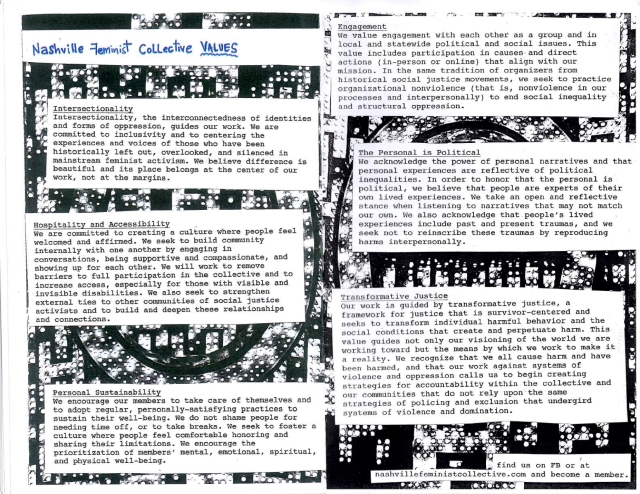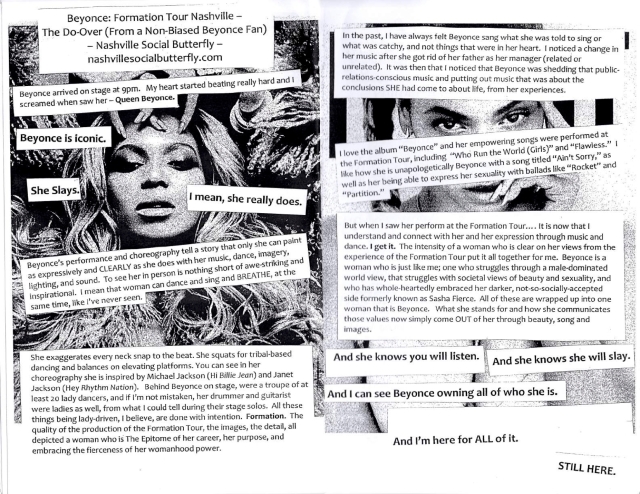Volume 2, Issue 3: Relationships
ESOTERIC
is a project of
The Nashville Feminist Collective
HBIC
Whitney Washington
Editors
Christine Doza, Anna Carella
Online Editor
Alexandra Axel
Contributors
Sarah Schulman, RJ Robles, JoJo Jackson,
Alexandra Axel, malikai,
Vala Bird, Kennon Lorick
Founder
Brooke Sonenreich
We want YOU to contribute to ESOTERIC!
The theme of our next issue is MAGIC
How does magic manifest in your life?
What is magical to you?
How to you invite magic into your world?
Who, what, when, where, why is magic?
…?
We center the work of women and gender-
non-conforming people of color.
Send your poetry, short fiction, personal stories, artwork, reviews, comics, etc. to
esoteric.nashville@gmail.com
by October 30, 2017 (for MAGIC)
Please include image descriptions with your submissions so that our zine may be accessible to those who use screen-readers to experience Esoteric through the NFC website. Image descriptions are straight-forward descriptions of the image, using whatever terms you like. If you include an image of yourself, we especially need an image description so that you may describe yourself as you want to be understood.
_____
NFC houses several working groups, in which members focus a feminist lens to work in a specific area of passion. Current groups and details for how to get involved are below
Esoteric. You’re holding it! Submission details are on the masthead (first page). We are always looking for layout and graphic design help, so if that’s in your wheelhouse, please be in touch: esoteric.nashville@gmail.com
Disability Justice Caucus studies and organizes around the principles of Disability Justice, which include Intersectionality, Leadership of the Most Impacted, and Collective Access. We meet on a regular basis to discuss these principles. We also host workshops on accessibility and are building an accessibility mapping project focused on activist spaces in Nashville. To get involved, follow us on Facebook or email aimi.hamraie@gmail.com.
Transformative Justice Working Group has prison abolition as its ideal goal. We meet monthly to read and discuss how the criminal “justice” system adversely affects woman, queer, and trans folks, particularly those of color. We take action with fundraisers (most recently for Black Mama’s Bail Out Day), the TN Prison Books Project, and working in coalition with like-minded groups. Get in touch via transformativejusticewg@gmail.com.
Nashville Feminist Youth Collective aims to develop young feminist leaders and activists through education, training, and skill building. Members of the NFYC will learn about and work to address sexist oppressions intersectionally through advocacy, education initiatives, and action. NFYC welcomes all folks ages 22 and under. Please contact socialjusticeshawn@gmail.com to get involved!
______
We at NFC and Esoteric are huge fans of Sarah Schulman’s Conflict is Not Abuse: Overstating Harm, Community Responsibility, and the Duty of Repair. She is the author of 18 books and has earned numerous prestigious honors. As an activist, Schulman was a member of ACT-UP, one of the founders of the Lesbian Avengers, is on the Advisory Boards of the Jewish Voice for Peace and Claudia Rankine’s Racial Imaginary Institute. She is one of my (Christine’s) personal idols, so I was beyond honored when she agreed to talk with me in her Lower East Side neighborhood in NYC, June 9th, on a stoop on East 9th Street.
E: What do you mean by “overstating harm”?
SS: I think that we’re in a global cultural moment where people are not considered to be eligible for compassion unless they’re purely innocent. Which is absurd because everyone deserves compassion. So when you have an artificial standard like that, it pressures people to paint situations as more uneven than they may be, so that they can get support. And in that process of exaggeration, I guess, there’s a kind of escalation that takes place. And that’s what I call overstating harm.
E: We like the idea of getting away from that binary “good guy vs. bad guy” way of looking at conflict.
SS: Sometimes there are good guys and bad guys. And one of the big problems with overstating harm is that it waters it down when people actually are in a situation where they’re completely overpowered. It becomes very confusing, and then people who need support may not be able to get it because there’s this distraction [by others] of the claim of pure innocence.
E: Right, well that perfectly leads me to my next question! On page 90 of your book, you say, “The rhetoric of overstated harm is especially damaging to poor and/or Black women who statistically need these paradigms [of abuse] while being denied access to them.” Can you discuss this?
SS: The paradox that we’re living in is that real abuse, which I define as “power over” is not attended to or recognized. But overstated harm, when it’s actually conflict, which I describe as “power struggle” - that inflation dominates attention. For example, right now, Trump – every single day he tells us what a victim he is, right? You know, it’s unfair, he’s under attack, it’s all lies. And it’s usually because somebody’s telling the truth about him. So he’s using these abuse tropes that other people authentically own to legitimate his position which is illegitimate. And this overshadows the reality of people who are excluded from power and also from support. Makes sense, right?
E: Yep. In your book you say, “Group shunning is the centerpiece of most social injustice.” Can you talk about how you connect group shunning on a personal level to the state and geo-political level?
SS: OK, well that’s gonna be hard to summarize because that’s –
E: What your whole book is about!
SS: - what the whole book is about.
[Laughter]
SS: Well, let’s start on the big level. So the centerpiece examples in the book are the 2014 Israeli war on Gaza, and the global trend of HIV criminalization. So in the case of Israel, they literally have separated Palestinians. Either behind a wall, in the case of the occupied West Bank, or under siege, in the case of Gaza. And so the people who they are subjugating, who they misrepresent as dangerous, are actually endangered by the separation. So that is on the most dramatic broad scale.
I’m amazed at how often people ask me to hurt other people. I’m often told, you know, “Why are you working with her?”, “Why did you invite them?”, “Why are you going there?” There’s this pressure to unite through some kind of negative bond, to build relationships through excluding other people, demonizing other people, blaming other people for our anxieties, for our pain that we can’t resolve. And, recently in Montreal, Morgan Page (who’s a Canadian writer) and I co-chaired a town meeting on queer suicidality and trans suicidality. And one of the things that people brought up was that when they get shunned by their friends or their families, they feel like they want to take their own lives. This separation is so dehumanizing. It’s so punishing. I’m 58, I’m old, and I’ve seen a lot and I don’t see any examples of punishment working. I can’t think of a single one, to be honest. So this punitive isolation or dehumanization, this pretending that the other person doesn’t exist when they do exist – which is what shunning is – to me all it does is it causes more pain. And instead, the discomfort of the communication that acknowledges that all parties are human is the only way to resolve conflict.
E: Do you think that kind of shunning that people seemed to be inclined to do – do you think that we start it and it’s mirrored by the state, or that we replicate what we see the state do?
SS: I don’t know, but I think they’re dynamic. Because when we isolate human beings who we know, because they make us uncomfortable or because they make us have to face things about ourselves or about our society that we don’t know how to resolve, we’re acting in concert with a ruling structure or by a government that maintains its power by being punitive.
E: I was really moved by the last paragraphs of your book where you talk about how the state doesn’t want us to have these conversations with each other because it’s in their interest for power to stay where power is.
SS: That’s at the core of HIV criminalization. Just so people know – HIV criminalization is a global trend where governments demand that HIV+ people disclose their status to their sexual partners. Even if they’re virally suppressed. Even if they’re using condoms. And I give the example of Canada, which has this great reputation which they don’t deserve, which has one of the worst HIV laws in the world. When I was examining their case, I did a piece for Slate magazine – that’s where I initially got interested in this – and I learned they had 250 people incarcerated under this law. As a journalist, my first question was, “Who are these people?” So when I looked I found out that half of them were Black – and this is CANADA, and there are no Black people in Canada – it’s 2.5% of the population. [Obviously] this is about racism and anti-immigrant hostility. So in HIV criminalization, the state looks at people who are negative who have anxiety about sex or fear of HIV and instead of helping us resolve those anxieties they heighten them. And they say, Denounce your sex partner, and in this way they create a whole new class of people who have the ability to incarcerate a whole other class of people. And every time you create a new group of people who can be incarcerated you enhance the power of the state.
E: And it tends to be people who are already vulnerable in some way.
SS: Oh, it has to be. It’s usually people who are endangered but are falsely represented as dangerous.
E: On p. 279 you say, “When we don’t refuse cruelty, ultimately we stand for nothing; we are hypocrites, and our public selves are phony.” This hit me pretty hard, especially when I reflect on the way people interact with each other on social media. What specific kind of cruelty are you talking about here, and why is this especially relevant to people active in social justice communities?
SS: Because if we advertise ourselves as people who take stands, who are trying to build other ideas about how we can all live together, then we take on a special responsibility to resolve problems instead of creating scapegoats. My book was not written with call-out culture in mind. I think I mention it once, in a very small sentence, but it’s been made entirely to relate to that … I mean, the book has sold miraculously 10,000 copies since October and for a book from a queer press in Vancouver that’s just astounding. And most of the people who are reading it are in their 20s. Because I’m doing book tours and I’m walking into rooms of 200 people and they’re in their 20s and 30s. So, people are there because they’re concerned in part about the collapse in our social relationships, but they’re very concerned about call-out culture. People are sick of it and they want a way out. And I wasn’t even thinking about that when I wrote the book, but apparently that’s another layer of the same structures that I’m addressing.
E: It’s interesting because I definitely thought about that when I picked your book up, and since I’ve read and have been talking with people about it, I’ve seen other articles popping up – it’s almost like the authors [of these articles] have read your book and summarized it. They make very similar arguments about how we [on the left] shouldn’t treat each other like we’re disposable. If we’re trying to create a better more just world, we can’t just drag our toxic shit in with us and keep acting towards each other in ways that we were acted against.
SS: Yeah but not just for ethical reasons but for practical reasons. Because it doesn’t work.
E: Yeah. Because you can’t build community.
SS: No, it just hurts people and divides people.
But I’m trying to understand why that’s there, and the reason that I propose is that the standard for who you have to be to be cared for and helped is so impossibly high that no one can meet it. So we have to construct these false selves that are so perfect and pure, and in that case I think your earlier suggestion that it’s a mimicking of the state is accurate because our state does not take care of anybody.
And the thing is, we’re in a national emergency and this is the time when we have to articulate what kind of world we want to live in. What are we fighting FOR? What are we moving TOWARDS?
E: Right, not just What are we fighting AGAINST?
SS: That’s why, though I’m sympathetic and I understand why a lot of activity on campuses is about stopping fascists from speaking, to me it’s not the most desirable strategy, because it’s not a strategy that puts forward How do we want to live and What are we FOR? And it’s a mistake to substitute stopping people from speaking for really talking honestly with each other about visualizing the world that we want.
E: We struggle with finding pro-active ways to change the culture around conflict in our community. You urge people to move away from binary perpetrator/victim thinking and toward a more nuanced understanding of conflict. But, because of temperament or other factors, many people are not inclined to view conflict with nuance. How do we meet people where they are?
SS: You know it’s interesting because I think what you’re talking about is – I’ve noticed this in some of the reactions to the book. There’s disagreement about the question of the unconscious. Here I’m a Jewish New Yorker in New York [laughs], the home of American psychoanalysis. But you know, I say it at the beginning of the book: I believe in the unconscious and I believe that we don’t always understand how we feel, why we do what we do. Sometimes we say things because we’re trying out saying things. We don’t have total access to our motives. And one of the goals of being a conscious person is to try to understand yourself better, but it’s impossible to completely KNOW. And so if you accept that, there’s more room for doubt, for failure, for mistake, and for interrogation [of the self].
If you have a fundamentalist idea of the individual - which I believe a lot of fundamentalist Christians hold and which I think Donald Trump holds - that you are entirely in touch with your motives, everything that you’re doing is deliberate, you’re always right, then it’s much much harder to negotiate. So that’s why I situate the solution in the larger community. In the group. I think we need a definition of loyalty and friendship as people who help other people be self-critical. So like right now, I wouldn’t want to be self-critical because right now if I’m self-critical publicly or if I acknowledge that something’s partially my fault, then people will use that to humiliate me and to isolate me and punish me.
But if instead, we embrace each other for taking responsibility, and the group, in a sense, rewards each other for taking responsibility, that helps people move forward. So what I think we should refuse is ganging up on someone. Like your friend broke up with their girlfriend so you’re gonna be mean to their girlfriend – which is standard, right? It’s based on family loyalty, tribe, and all of that stuff. And that’s the kind of thing we have to avoid. This organized shunning, this group hurting of individuals because they have a conflict with someone we identify with. This is what nationalism is based on. This is what racism is based on. It’s not a positive construction. So if there’s an individual who’s unable to be self-critical, it’s the group’s responsibility to show their love and friendship by not reinforcing punitive blaming and scapegoating.
E: So as individuals, we should just model that behavior?
SS: Well the thing that I suggest is calling up the negative object and saying like, “Why do you think this is happening?”
E: And [you also suggest asking], “What would the other person say happened?”
SS: Right, that’s the next thing. Because, if someone’s asking you to hurt someone, like if you say to me “I want you to be mean to my ex-girlfriend,” and I say to you, “Well, what does she think is happening?” If you can’t really tell me, then you don’t have enough information. Ditto: Palestinians, poor people, anybody who’s blamed and excluded and silenced. We don’t hear from them what their point of view is and how they understand their own experience.
E: And so, to change the culture around conflict [am I correct in understanding], it’s a grassroots effort of people deciding to change and modeling that with their behavior in the community?
SS: Well that’s why, in the book, I contrast 4 different systems, which are very different from one another. Classic psychoanalysis, pop psychology, Al-Anon, and mindfulness. These are systems that couldn’t be more different from each other, but I show that they all share 2 values. One is the value of delay. Which means that if you think things over, you’re less likely to escalate. And the second is the positive group. You know, everybody needs a place where they can be self-critical, and that’s a positive group relationship. We’re involved in a lot of negative groups that are about hurting other people and deflecting blame, but we all need positive groups, whether it’s a 12-step meeting, a place with a therapist, a group of friends who really encourage self-criticism. And I think cliques are incredibly important in our community. I mean, cliques are the number one apparatus of social control in the queer community, right? And they can be used for ill or for good.
E: As a group that understands that issues of identity and collective trauma experienced by people within oppressed communities are serious issues, do you have any advice on how to negotiate with each other when personal trauma, collective trauma, and political identity become conflated?
SS: I would have to have a concrete example.
E: Say, people in social justice communities coming together to organize a protest or some sort of action, and there being in-fighting and mistrust among people in that group because they have differing political identities – racial identities, gender identities, for example. Because those personal or collective traumas are being worked out in this public space. Does that make sense?
SS: I would have to have a specific example. Let me tell you why I need specifics and maybe that will be the answer. Let’s take for example, the sexual abuse debate on campus. OK, so you look at that debate, and in every environment there are real predators who enjoy breaking people’s will. And they exist. But then, there’s also this huge grey zone area, where things happen that some people don’t think are abuse and other people do. And as you start to talk to people, you find out that two people could have the exact same experience, and one person could think, “Oh well, that sucked,” and the other person could be devastated for life. And what you learn from that is that it’s not the experience itself which has an inherent value or meaning, it’s what individuals bring to it, what their histories are, what their characters are, all of that kind of stuff. So what it shows you is that you can’t always have established standards or rules that tell you how you’re gonna respond. You have to actually listen to people and hear who they are to determine what would be appropriate. So, in a way I’m against standardizing responses.
E: What I really liked about your book is the nuance with which you consider conflict. I feel like my brain was rewired to have a new perspective about what’s really happening in [situations of conflict]. That we have the option to ask questions when we don’t understand or like what someone has said – and I think I have to underscore that in my experience, these kinds of conflicts happen almost exclusively on social media. People speak and make accusations in a way they simply wouldn’t do to your face.
SS: It would be interesting if we could honestly ask people, “Why did you feel compelled to comment because this person used a word you didn’t like?” Are you protecting somebody else? Are you expressing anger? It would be interesting to ask those questions. Or you could just let it go. There’s also that option.
E: True. I thought the parallel you draw between the behaviors of people motivated by supremacy ideology and those of people motivated by unresolved trauma was very insightful.
SS: I gotta tell you, I think it’s the smartest thing in the whole book. Because this book has, like, hundreds of ideas and some are a little wonky, let’s be real, but that one …
E: Which ones do you think are wonky?
SS: Let’s talk about the criticisms in a minute. I realized that people coming from a place of supremacy feel entitled to never be opposed, and can destroy you for simply being different or asking them to think about themselves. But then I realized that people who have unresolved trauma can do the same thing but for completely different reasons, because sometimes we just feel so fragile that we can barely keep it together anyway. And then when we’re being opposed and asked to question ourselves, and we don’t feel good about ourselves, it just feels too threatening. And I realized that the same action of trying to destroy difference can come from a traumatized person as from a supremacist person. And I was like, Wow, that’s helpful.
E: I think that’s really helpful too.
SS: Yeah. So in terms of criticisms. There’s been a lot of different kinds of criticisms of this book. My favorite kind are when people have read the whole book and then accurately restate an argument of mine, and then explain why they don’t agree with it. I love that. I call that “principled disagreement.” The most interesting comments to me in the arena of principled disagreement have been about generational differences about technology. Because, to me, my frustration with technology is that it’s an obstruction to communication. And that’s so rooted in my generational position. I know that I’m being attacked on platforms that I don’t even know how they work!
[Laughter]
SS: So, it’s true. And that people who grew up on this can solve problems through text better than I can. And to have all of that be articulated I think is accurate. Then there’s the stuff that drives me crazy. So before the book even came out, there was an attack on Tumblr claiming that my book was telling people to call the police.
E: What? You never say that!
SS: No, I say the opposite. The entire book is about alternative to calling the police. And this thing has been reposted hundreds of times. And people who I have no idea who they are – I’ve never met them, I’ve never heard their names before – were spamming Facebook invitations to my various readings with these posts. And that was like, whoa.
E: That’s upsetting.
SS: Yeah, and then there are other people who say, “Schulman is a known abuser. It’s well known.” [Laughter] OK? People are like, “She broke her girlfriend’s nose,” stuff like that.
Just for the record, I have never committed an act of violence. Let me just say that, and I say it in the book as well. But just outrageous stuff!
E: Where is that coming from?
SS: Other people will ask, “Where is your evidence for [these claims]? And they respond, “It’s well known”!
E: And what’s so ironic about that is it’s exactly the kind of thing you are asking people not to do.
SS: Right. But they never read the book, so they don’t realize that.
And then there’s the people who misstate my ideas and then say why they’re wrong. For example, one of the things I say in this book is that there are thousands of books about abuse, and this is not one of them. This book is about conflict. So then I’ll get a take-down saying, “This book shouldn’t be about us trying to understand the difference between conflict and abuse, it should be about how it feels to be abused.” No, it shouldn’t be. That’s not what it’s about. And what I think that is all about, is that there’s a pervasive fear of the new, and the book really has ideas that have never been seen before, and so if you don’t read it, you can’t know what those ideas are. But if you think it’s an idea that you’ve heard before, and you project that onto it, then you can disagree with it. But you can’t disagree with a new idea that you haven’t read. It’s not possible. [Laughter.]
So the basic idea of the book is that when we abdicate responsibility for our contribution to conflict, we enhance the power of the state. That is the idea. If the critique is only about the interpersonal, and does not engage the role of the state, they haven’t read the book! The book is not self-help for leftists. That’s not what it is. [Laughter.] It’s analysis. So that’s been frustrating. So please read it. Or else, don’t comment.
E: Alright, last question. It’s big one, are you ready?
SS: “Why did you break your girlfriend’s nose?”
[Laughter.]
E: No. If you were to write Conflict Is Not Abuse: Part 2, what would you include?
SS: It would be called Read the Book. [Laughter.] I’ve never had this problem before! It’s my eighteenth book. I have never had that before, where people viciously take down something that they have no idea what it is.
E: Do you think it’s because the word “abuse” is in the title?
SS: It’s because the words “not abuse” are in the title. People are afraid that I am somehow going to take away their hard-earned status as a person who’s been abused. And that’s not what I’m doing, at all. In fact for people who have actually been abused, the book is, I think, highly supportive. And you know — I ask this in the book, but it’s something that still puzzles me. Wouldn’t it be preferable to understand that you are a contributor to the problem because then you have the power to resolve it? Why would we rather be helpless?
E: I think that’s so powerful. Because we all have the power to do shitty things, but we also have the power to repair that harm. And that’s really powerful. So thank you Sarah Schulman!
SS: Thank you!
_____
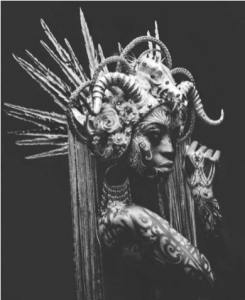
an image of the Greek goddess Hecate. The woman is wearing an elaborate headdress and large dangling earrings. Her skin and face are painted. She is in profile but turns her head to look at the camera
Try breathing when someone is standing on your neck in stiletto heels
My girlfriend puts
Gunpowder inside my pussy
Sets me on
A different kind of fire
When things don’t go her way
So I get into position
To get fucked
But this aint lovemaking
This is me
Becoming another slim and silver body beneath her
Awaiting
Awaiting her carelessness
Bearing the wait
Of all of her insecurities
I cant breathe
Because she too much patchwork
Me and God take turns
Holding her shit
And she was my Hecate
With an ego problem
Peeing in jars of lavender
Daring me not to drink
Telling me what dreams
Deserve the light
While erasing possibility
Because I didn’t have your dreams or a house at your age
Why you stay busy trying to color the world with beauty
Why do you give strangers kindness from your soul
When they have not earned it
Love aint tyranny
You are not my maker
Not a God
Not my God
No I will not let you
Cover me with blessings
that surely bleed
Or give me rope
You hope I hang myself with
Or better yet
You hope to dangle
And call it mercy
And this why
I no longer speak
To a woman who thinks the world is scarce
Like smiles that shine
When they are not for her
Adornment.
Contact malikai at Writenow2017@gmail.com
_____
Love Me Always: A Trans Perspective on Relationships
I have been a nomad in my own flesh.
I am not a man or a woman.
I am a genderqueer, Brown, Puerto Rican, Latinx.
I am not a walking encyclopedia of trans knowledge.
Do your homework, step it up.
I have scars, a wounded heart, do not abuse me.
I am so many things.
The labels are not enough.
The queer and trans, brown and black runs deep through my blood.
My ancestors walk with me even though sometimes I forget.
The boxes I check.
The bathrooms I use.
The clothes I wear.
The shoes I introduce.
How I walk, sit, talk, and even breathe.
I am conscious of everything.
Future lovers, partners, boos, and honeys.
I am not your research project.
I am not a toy for your sexual liberation.
Believe me when I say what my pronouns are.
Believe me even when you are conditioned to read my body a certain way.
Fight your automatic impulse to silence me with your gender binary.
Show me mercy, have patience when I feel down.
Show me kindness and compassion.
Do not discriminate me in your sexual attractions.
Come into my gender unicorn world, and be free!
Sometimes I need you to love me despite of my body.
Sometimes I need you to love my body when I don’t.
Sometimes I need you to love this flesh because it hasn’t known love.
Sometimes I need you to just love my trans spirit.
Love me today for who I am, not what you see.
Love me tomorrow for who I am becoming.
Love me the following day for having survived this cis, hetero, white world.
Love me next week because I may be a victim of someone’s transphobia and racism.
In relationship with this trans being you need to be mindful.
With this trans person you need to ask for consent before touching.
With this trans spirit you must be honest.
In relationship with me, you must remember that I was never meant to survive.
I find myself in the midst of the Garden of Eden.
Co-creating my body with magical power.
With each breath I regenerate.
Into a field I look, going past,
The ground around us is almost covered with grass.
I carry my pain with me,
I’ve learned to heal wounds you may never see.
I am co-creating my gender with divine power.
You can touch and feel the waters of liberation
I am a gender unicorn in the clouds of witnesses
Fly with me, let’s fight for justice together.
I show you my arboretum
The trees are looking at God
The branches are open wide
They offer you kindness,
They offer you freedom
They give you my love.
My resilience meets your fears.
My pride meets your confusion.
My tears meet your smile.
My worries meet your faith.
Let us soak it all in together.
Journey with me.
Love me always.
Love me unconditionally.
Love me regardless of labels.
Love me because I am certain of who I am and was called to be.
Love me ever so deeply
Loving me takes time and commitment
Loving me is a radical act of resistance.
Love me it’s all I ask of you.
My work is about liberation, trans justice, religion/faith & spirituality, trans healthcare, and healing justice & work. Readers can support me via FB as Rj Robles or via email at rj.robles.genderqueer.qpoc@gmail.com.
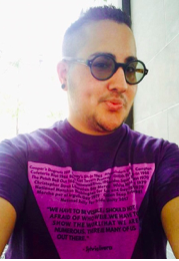
brown, trans, Latinx giving a smiley kiss to the camera, wearing a purple shirt with a pride triangle and the words of Sylvia Rivera
______
hold water, reflect light
by alexandra axel
…
something is being squeezed out of me. you are telling me that you want to have sex with her and i say okay. i don’t sleep that night. you’re holding me and i’m thinking of the two of you together.
this is the first time. (they say the first time is the worst.)
i am not doing this for you. i recognize the ideas i have of security are nothing more than what was sold to me. no one can be anyone’s everything. but i have no reference point for this feeling. no episode of buffy lessoned me on non-monogamy. no beyoncé song. i search through my bookshelf, through my music, my movies and find nothing.
for two weeks i beg myself to hate you. i rage at you through lemonade. i yell along to the album until i lose my voice. i keep thinking: what a wicked way to treat the girl who loves you. i keep thinking: how could you do this to me? except you’ve done nothing wrong. you haven’t cheated. we both agreed to sleeping with other people and dating only each other. you’ve only ever shown me unconditional love.
this is the first time for me. this is not yours.
this relationship posed a question and the answer is being squeezed out of me. it is old, older than me. it is the oldest answer i have: it is my mother and father meeting for the first time and it is the person my father became, three years later, when his father died: drunk and angry. it is fifteen years of throwing things and teeth grinding and hair pulling and belting and calling the cops. it is all of the adults who failed to see what was happening. it is my half-sister who visited but never took me away.
it is a legacy: of body dysmorphia. of depression. of trauma. of codependency. of sexual repression.
it is all being raked to the surface. it is fear it is fear it is fear.
it’s just sex.
i get it in theory—i have spent a long time getting it in theory. i get that your desire for her doesn’t mean anything about me. i’m enough and you can want to sleep with other people. you’re enough and i can want to sleep with other people. these are both truths. you want me and you want her: in different ways, in similar ways.
i spend hours every day picturing you two together. it is my meditation practice. she is fucking you, you are fucking her. you’re using the same strap on with her that has made me come, the same fingers, the same lips. my chest feels tight, my skin burns. i stop eating for days. everything makes me nauseous.
i will move through this. this is a feeling and i will move through it.
two weeks later and i begin to emerge. i wake up from a dream of you and her and i feel excited. i am happy she made you feel good. i tell you this. you are excited for us, i am excited for us. i am relieved.
ajahn chah says to picture the glass broken. love the way it holds water and reflects light but know that it will break one day. know that every moment with it is precious because all things end.
this is my new meditation: i picture you fucking every single one of my friends. i picture you sleeping with people i am jealous of. i picture you sleeping with people i don’t like. and still—i love the way you hold water and reflect light. i know that monogamy does not equal permanence. nothing does.
five months later, and we are driving to new orleans. i am gathering my breath, getting ready to ask you: have you slept with anyone else? i already know the answer and the answer is yes. okay, i say. okay. i breathe. i remind myself that nothing has changed between us. another big squeeze but everything is okay.
but when we return to nashville, i find that i am getting jealous again. this jealousy is multi-faceted: it is of you, of them, of it. i lose my appetite again. i feel paranoid and urgent. i feel that i will never catch up to you. it’s not a race, i remind myself. (it feels so much like a race sometimes.)
i am angry that i have to undo this thinking about what love and relationships look like. i’m angry that this insecurity was installed in me via capitalism, via the patriarchy. but i am doing the work. i am committed to the work of undoing, of building new. i am committed to you.
i am committed to me.
when i came out, i remember standing in front of the mirror, practicing saying “i’m queer” over and over and over again until the fear and discomfort went away.
this is my new mirror practice: my partner might have more sex than me. my partner might have better sex than me. i am breathing through it. i can undo competitiveness, undo jealousy. i can replace it with something slower. for instance: love. for instance: gratitude.
for instance: thank you for showing me what love can look like.
we will continue as a slow unfolding: there is still more that is being squeezed out of me. old ideas. scarcity- and deficit-based thinking. fear of abandonment. that programming needs to go, with or without you around. so it goes. every day is a letting go.
i am imagining every glass broken. each one is an idea that no longer serves me. i am imagining every glass broken. each one makes me more whole.
i am imagining no limit on expansion, to what can hold water and reflect light.
You can find more of Alexandra’s work at alexandraaxel.com
________
Natural Health - Yoga
Partner Yoga is a great way to nurture and to show support in your relationship. You’re using one another as props to find greater depth or better alignment in your pose and by extension in your relationship. Your partner doesn’t have to be your romantic partner – they can be a friend, family member, fellow-yogi or anyone you feel comfortable sharing the pose with.
Past Lord of the Fish Pose – spinal twist
Spinal twists are one of the 4 major motions of the spine (back-bending, forward-folding, and flexing side-to-side are the others), so twisting helps maintain a healthy range of motion in the spine. Twisting also massages the internal organs - colon, liver, spleen, kidneys – which helps keep the digestive tract regular. Twists are also good for massaging into the endocrine glands in the neck – the thyroid and parathyroid glands – which are responsible for metabolism and sleep cycle. This particular twist, since it gets into the hips, is also good for the reproductive organs. Energetically speaking – and not to get too esoteric - a twist is a healthy movement to keep your chakras balanced.
1. Sit back-to-back on the ground, both partners have legs extended out straight in front of them.
2. Each partner crosses left foot over right knee and places the left foot on the ground. Gently roll to the edge of the right hip so that you can bend your right knee and bring right foot to the outer edge of the left hip. Right foot will be lying on its side. [Variation – you may also keep the right leg straight if bending it does not feel right for your body.]
3. Bring right elbow over your left knee and twist to the left. Then, each partner uses right hand to hold on to their partner’s left shin or ankle.
4. From there, inhale deeply.
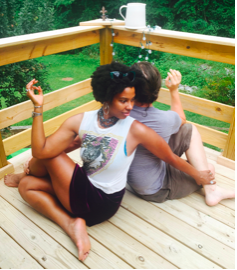
JoJo sits back-to-back with her partner, her left arm reach back to hold onto his ankle, her right arm propped against her bent left leg
5. On the exhale, twist a little more to your left, gazing over your left shoulder. Each partner can relax firmly onto the other’s back to keep the spine upright.
6. This partner-variation of the twist is especially valuable for keeping the spine long. The way that each partner rests on each other’s back helps deepen the pose because of the support. Maintain the pose for about 30 seconds, remembering to breathe and twist a little deeper on exhales.
8. Then switch sides, mirroring everything you did on the first side.
9. Relax and enjoy the benefits of the spinal twist!
FB: @yogibassistnashville. Insta: @yogibassist; Email: yogibassist@gmail.com. questions or interested in private lessons or where you can find Jo-Jo teaching classes in Nashville
________
I have to start this off with the obligatory “I’m not a writer” disclaimer. I haven’t written a full page description of my situation since I wrote my Withdrawal Letter to Grand Valley State University. So what am I doing writing a piece for Esoteric’s Relationship Issue? How I treated college is how I treat relationships—with rapidly fading enthusiasm. I love first impressions, first kisses, first broken condom… I’m a Scorpio Moon so I feel love for others so deeply, but I have no interest in showing vulnerability. Being vulnerable with another person is how you reach Romeo & Juliet love status and I ain’t tryna die for no white boy. My name is Vala Bird and I’m a stand-up comedian, born in Texas to two Nigerian immigrants who did not love each other. Consequently, I’m very afraid of monogamy and commitment. I’m writing this to explain how and why identifying as non-monogamous has helped me be happier in my relationships.
As a comic, I turn every setback into a joke. That joke is my Band-Aid, it helps me heal. But under that Band-Aid there is still a scar from the initial wound. Growing up, I had very little emotional support which resulted in a plethora of issues including but not limited to: daddy issues, intimacy issues; both of which still affect my relationships. When I say non-monogamous, I don’t mean polyamorous. Polyamory is the desire to have more than one intimate partner at a time. Partner is the key word. I have been a secondary character in a polyamorous relationship. They were the primary couple, they were in love. I don’t have the time or energy to devote to another human, 100%. I am alone, a free agent of sorts. I give you all of me but only for days, weeks or months at a time. Then our relationship becomes less convenient and I fade out of your life.
Here’s the deal, I’m non-monogamous because I have tried and failed to be committed to one person. Literally, every time I get a boyfriend, I cheat on him. There is something about belonging to one person for an undisclosed amount of time that scares me and I need to move on first. I date men with what I call “fatal flaws,” that way I have a built in reason to stray. For example, I’m a very sexual person and I have dated TWO men that were celibate. It took me two laughable months of self-restraint before I cheated. I want to be a comedian; I want to travel, write jokes and explore the world and then maybe fall in love on the way. Non-monogamy is an approach to relationships that works better for my destiny.
Also, I am non-monogamous because I am afraid of intimacy. Y’all… I’ve never even seen The Notebook. It hasn’t been easy coming to terms with this. Most of my romantic relationships overlap and I’ve created a lot of “eskimo brothers.” These aren’t one-night stands though, I care about these men. We connect and it’s so fresh and new and special. I obsess over them, give them my time, have sex with them habitually for months and months and then before things have a chance to get stale – I fall madly in love with someone else. It’s not normal and that’s okay.
I feel very honored to be able to share a glimpse into the process of accepting my own non-monogamous lifestyle. Before beginning this, I didn’t realize how little I knew about the poly community. Everybody knows the ol’ Netflix & Chill but people don’t talk about the emotional highs and lows that come with having a casual attitude towards sex. Non-monogamy is a relationship style, and I honestly don’t think it’s any better or worse than monogamy. If you asked two people, 1 strictly monogamous, 1 strictly non-monogamous how they feel about their relationships as a whole I think they’d say the same thing. Sometimes I feel undervalued and worthless, sometimes I feel loved and appreciated. It all depends on who I’m with.
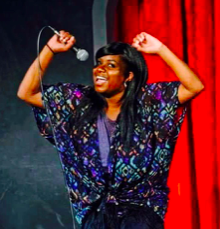
BBW African American female, long black hair with side swept bangs in multi colored shawl. The stage wall is black with a bright red velvet curtain. She is on stage, with a microphone performing a joke she calls “Air Sex”. She is smiling, her eyes are wide and her tongue is out. She is holding her arms above her head, hands in loose fists, one holding the microphone. She is making her mom proud by mimicking fellatio on two “air dicks”.
Non-monogamy works for me. I had to go through a lot and put my exes through even more in order to finally understand myself. I don’t want to be committed to one person forever. When I hear an N’SYNC song I imagine that all five guys are singing to me. I think I could have meaningful relationships with them all haha. Or at least I’ve got enough optimism and imagination to give it a try. I’m kidding (no I’m not). Stand-up comedy has been a vital tool in allowing me to analyze my setbacks/scars without shame. I’m still not a writer; so thank you, Nashville Feminist Collective, for giving me a chance to a part of Esoteric’s Relationship Issue. Sincerely, the African, American, Black, Female, Straight, Feminist. Non-monogamous, Nymphomaniac, Non-writer, College Drop-Out, Comedian. – Vala Bird
Facebook: Vala Bird, Instagram: vala_bird13, Twitter: vala_bird. You can find me open mic-ing it Tuesday nights @The East Room & Wednesday nights @ Smith & Lentz. I’m regularly at Third Coast Comedy Club.
Volume 2, Issue 2: Flesh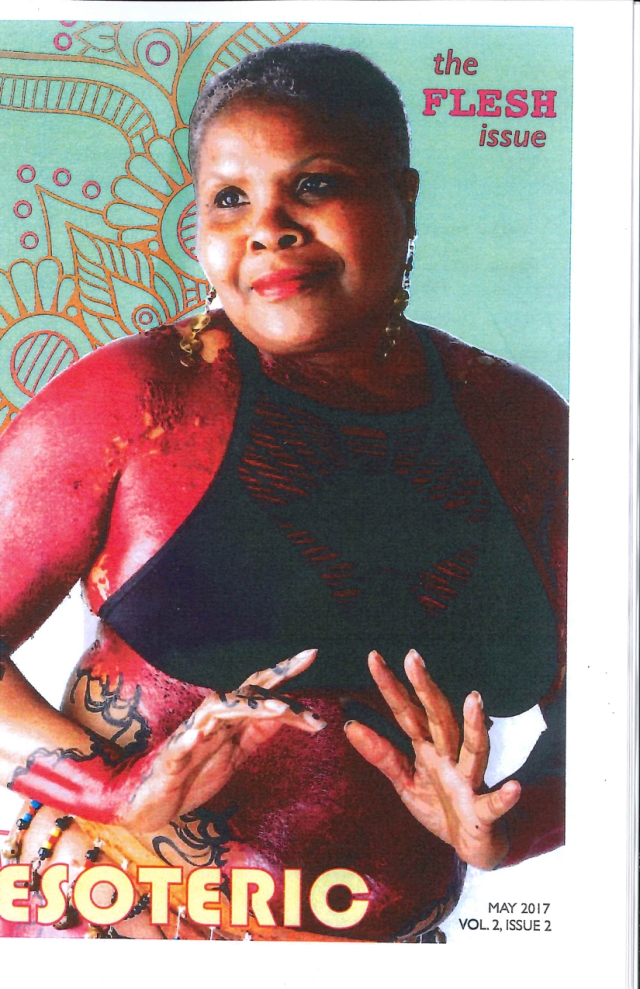
Cover: [A seasoned woman in red body paint and red lips looks just to the left of the camera. She holds her hands daintily outward, palms facing out and down. Her fingers are long and elegant and her nails are rounded. She is wearing a black mesh halter top with a web-like woven pattern across her breasts. Long earrings dangle to her shoulders. Around her midsection, black body paint curls into the red to make a pattern. Behind her, the cover reads “The Flesh Issue.” Across her midsection is the title, “Esoteric.” Bottom right reads “May 2017, Vol. 2, Issue 2.” At the top right of the cover are orange and red floral graphics against a green background.]
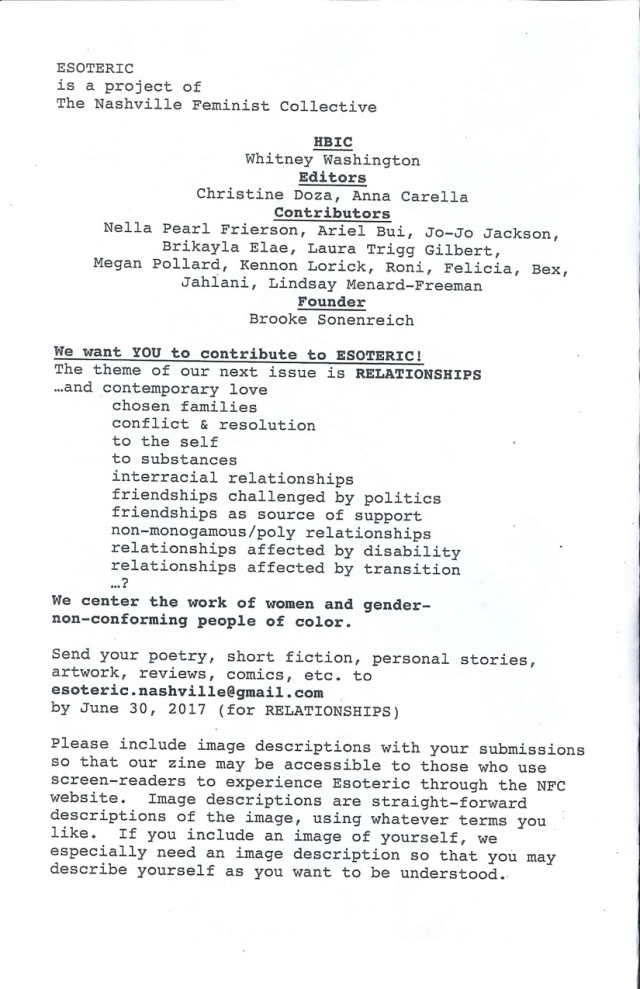
Page 1: Masthead – no images
ESOTERIC is a project of The Nashville Feminist Collective
HBIC
Whitney Washington
Editors
Christine Doza, Anna Carella
Contributors
Nella Pearl Frierson, Ariel Bui, Jo-Jo Jackson,
Brikayla Elae, Laura Trigg Gilbert,
Megan Pollard, Kennon Lorick, Roni, Felicia, Bex, Jahlani, Lindsay Menard-Freeman
Founder
Brooke Sonenreich
We want YOU to contribute to ESOTERIC!
The theme of our next issue is RELATIONSHIPS
…and contemporary love
chosen families
conflict & resolution
to the self
to substances
interracial relationships
friendships challenged by politics
friendships as source of support
non-monogamous/poly relationships
relationships affected by disability
relationships affected by transition
…?
We center the work of women and gender-
non-conforming people of color.
Send your poetry, short fiction, personal stories, artwork, reviews, comics, etc. to
esoteric.nashville@gmail.com
by June 30, 2017 (for RELATIONSHIPS)
Please include image descriptions with your submissions so that our zine may be accessible to those who use screen-readers to experience Esoteric through the NFC website. Image descriptions are straight-forward descriptions of the image, using whatever terms you like. If you include an image of yourself, we especially need an image description so that you may describe yourself as you want to be understood.
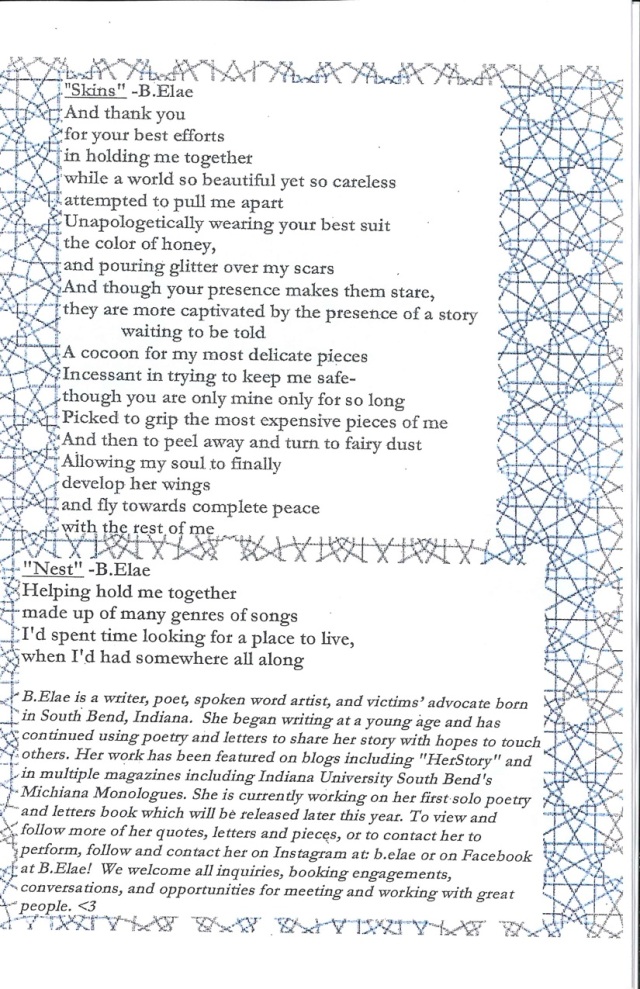
Page 2: B. Elae poetry – no images
“Skins” -B.Elae
And thank you
for your best efforts
in holding me together
while a world so beautiful yet so careless
attempted to pull me apart
Unapologetically wearing your best suit
the color of honey,
and pouring glitter over my scars
And though your presence makes them stare,
they are more captivated by the presence of a story waiting to be told
A cocoon for my most delicate pieces
Incessant in trying to keep me safe-
though you are only mine only for so long
Picked to grip the most expensive pieces of me
And then to peel away and turn to fairy dust
Allowing my soul to finally
develop her wings
and fly towards complete peace
with the rest of me
“Nest” -B.Elae
Helping hold me together
made up of many genres of songs
I’d spent time looking for a place to live,
when I’d had somewhere all along
B.Elae is a writer, poet, spoken word artist, and victims’ advocate born in South Bend, Indiana where she began writing at a young age, and has continued using poetry and letters to share her story with hopes to touch others. Her work has been featured on blogs including “HerStory” and in multiple magazines including Indiana University South Bend’s Michiana Monologues. She is currently working on her first solo poetry and letters book which will be released later this year . To view and follow more of her quotes, letters and pieces, or to contact her to perform, follow and contact her on Instagram at: b.elae or on Facebook at B.Elae! We welcome all inquiries, booking engagements, conversations, and opportunities for meeting and working with great people. ❤
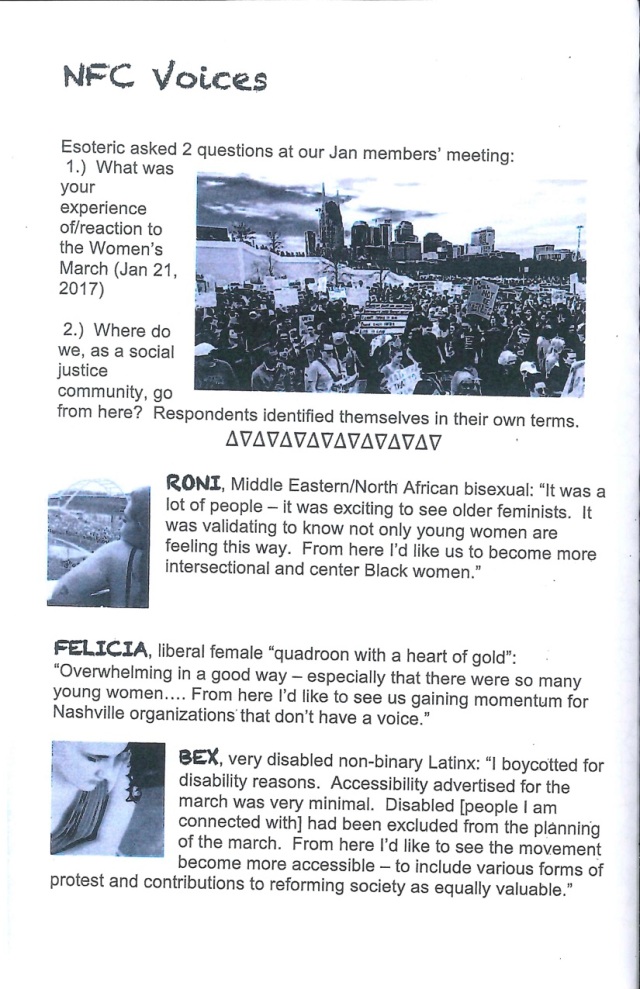
Page 3: NFC Voices, 3 images.
Esoteric asked 2 questions at our Jan members’ meeting:
1.) What was your experience of/reaction to the Women’s March (Jan 21, 2017)
2.) Where do we, as a social justice community, go from here? Respondents identified themselves in their own terms.
[Black and white photo of the Nashville Skyline with clouds in the left portion of the sky. In the foreground, hundreds of assembled people hold signs. They are participating in Nashville’s Women’s March.]
∆∇∆∇∆∇∆∇∆∇∆∇∆∇∆∇
RONI, Middle Eastern/North African bisexual: “It was a lot of people – it was exciting to see older feminists. It was validating to know not only young women are feeling this way. From here I’d like us to become more intersectional and center Black women.” [Image: Young girl with wavy black hair is leaning against the railing of a bridge. Her back is towards the camera but her head is tilted slightly to the left so you can see that side of her face. On the back of her left arm above her elbow is a small tattoo with the female sex symbol and the words “grl pwr”. In the background you can see a large people getting ready to walk for the Women’s March.]
FELICIA, liberal female “quadroon with a heart of gold”: “Overwhelming in a good way – especially that there were so many young women…. From here I’d like to see us gaining momentum for Nashville organizations that don’t have a voice.”
BEX, very disabled non-binary Latinx: “I boycotted for disability reasons. Accessibility advertised for the march was very minimal. Disabled [people I am connected with] had been excluded from the planning of the march. From here I’d like to see the movement become more accessible – to include various forms of protest and contributions to reforming society as equally valuable.” [Image: In the background is a neutral-colored wall. I am sitting with my forearm resting along my knees, looking down, and wearing a one-strapped, light-blue dress. The photo is zoomed in on my upper body and angled to show the side of my face and one shoulder. I am wearing a silver nose ring and brown lipstick and my hair is falling down along the right side of the image.]
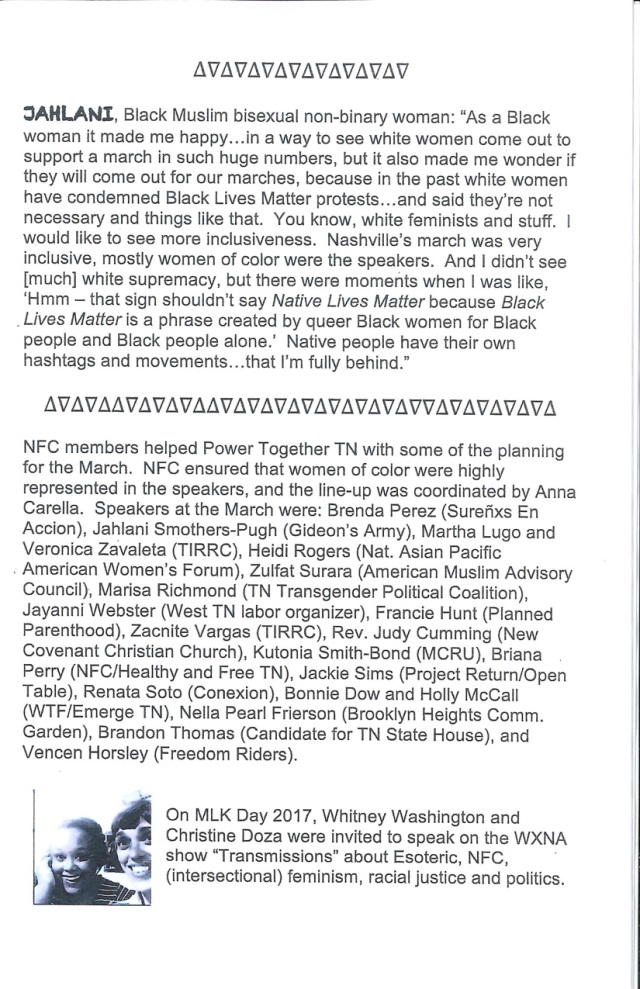
JAHLANI, Black Muslim bisexual non-binary woman: “As a Black woman it made me happy…in a way to see white women come out to support a march in such huge numbers, but it also made me wonder if they will come out for our marches, because in the past white women have condemned Black Lives Matter protests…and said they’re not necessary and things like that. You know, white feminists and stuff. I would like to see more inclusiveness. Nashville’s march was very inclusive, mostly women of color were the speakers. And I didn’t see [much] white supremacy, but there were moments when I was like, ‘Hmm – that sign shouldn’t say Native Lives Matter because Black Lives Matter is a phrase created by queer Black women for Black people and Black people alone.’ Native people have their own hashtags and movements…that I’m fully behind.”
NFC members helped Power Together TN with some of the planning for the March. NFC ensured that women of color were highly represented in the speakers, and the line-up was coordinated by Anna Carella. Speakers at the March were: Brenda Perez (Sureñxs En Accion), Jahlani Smothers-Pugh (Gideon’s Army), Martha Lugo and Veronica Zavaleta (TIRRC), Heidi Rogers (Nat. Asian Pacific American Women’s Forum), Zulfat Surara (American Muslim Advisory Council), Marisa Richmond (TN Transgender Political Coalition), Jayanni Webster (West TN labor organizer), Francie Hunt (Planned Parenthood), Zacnite Vargas (TIRRC), Rev. Judy Cumming (New Covenant Christian Church), Kutonia Smith-Bond (MCRU), Briana Perry (NFC/Healthy and Free TN), Jackie Sims (Project Return/Open Table), Renata Soto (Conexion), Bonnie Dow and Holly McCall (WTF/Emerge TN), Nella Pearl Frierson (Brooklyn Heights Comm. Garden), Brandon Thomas (Candidate for TN State House), and Vencen Horsley (Freedom Riders).
On MLK Day 2017, Whitney Washington and Christine Doza were invited to speak on the WXNA show “Transmissions” about Esoteric, NFC, (intersectional) feminism, racial justice and politics. [Image: Whitney and Christine have their heads as close together as the big headphones they are wearing will allow. Whitney is wearing and black-and-white striped shirt and smiling into the camera. Christine is smiling too but she looks goofy and nervous.]
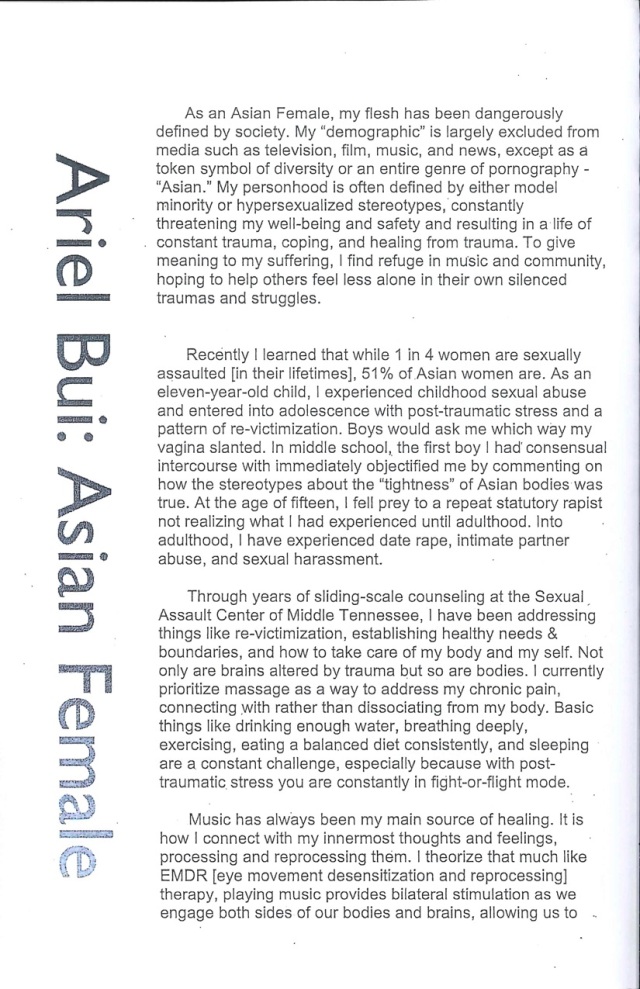
Page 5: Ariel Bui – no images
As an Asian Female, my flesh has been dangerously defined by society. My “demographic” is largely excluded from media such as television, film, music, and news, except as a token symbol of diversity or an entire genre of pornography - “Asian.” My personhood is often defined by either model minority or hypersexualized stereotypes, constantly threatening my well-being and safety and resulting in a life of constant trauma, coping, and healing from trauma. To give meaning to my suffering, I find refuge in music and community, hoping to help others feel less alone in their own silenced traumas and struggles.
Recently I learned that while 1 in 4 women are sexually assaulted [in their lifetimes], 51% of Asian women are. As an eleven-year-old child, I experienced childhood sexual abuse and entered into adolescence with post-traumatic stress and a pattern of re-victimization. Boys would ask me which way my vagina slanted. In middle school, the first boy I had consensual intercourse with immediately objectified me by commenting on how the stereotypes about the “tightness” of Asian bodies was true. At the age of fifteen, I fell prey to a repeat statutory rapist not realizing what I had experienced until adulthood. Into adulthood, I have experienced date rape, intimate partner abuse, and sexual harassment.
Through years of sliding-scale counseling at the Sexual Assault Center of Middle Tennessee, I have been addressing things like re-victimization, establishing healthy needs & boundaries, and how to take care of my body and my self. Not only are brains altered by trauma but so are bodies. I currently prioritize massage as a way to address my chronic pain, connecting with rather than dissociating from my body. Basic things like drinking enough water, breathing deeply, exercising, eating a balanced diet consistently, and sleeping are a constant challenge, especially because with post-traumatic stress you are constantly in fight-or-flight mode.
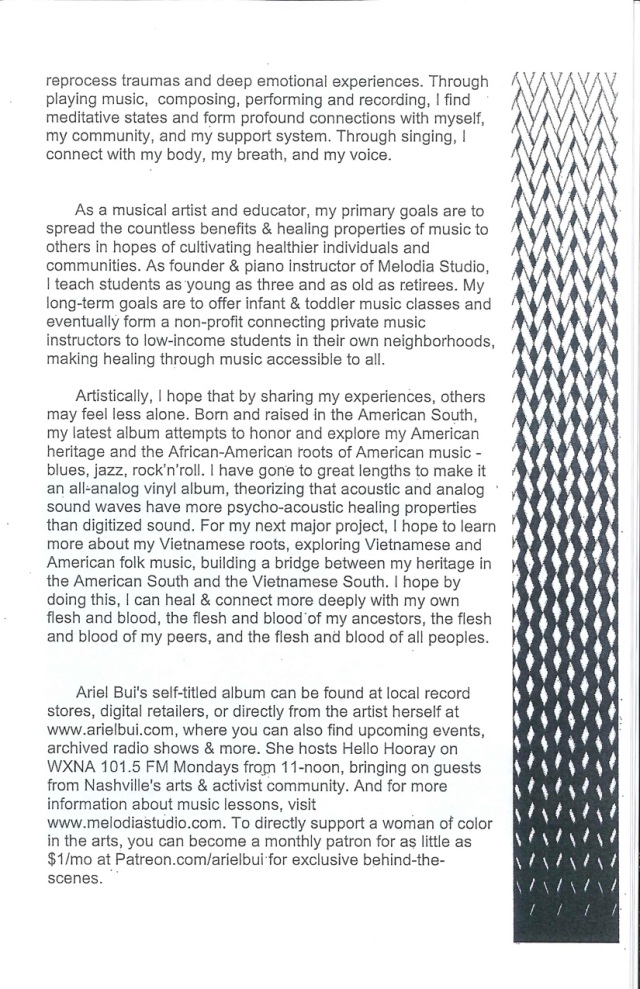
Page 6: Ariel Bui – no images
Music has always been my main source of healing. It is how I connect with my innermost thoughts and feelings, processing and reprocessing them. I theorize that much like EMDR [eye movement desensitization and reprocessing] therapy, playing music provides bilateral stimulation as we engage both sides of our bodies and brains, allowing us to reprocess traumas and deep emotional experiences. Through playing music, composing, performing and recording, I find meditative states and form profound connections with myself, my community, and my support system. Through singing, I connect with my body, my breath, and my voice.
As a musical artist and educator, my primary goals are to spread the countless benefits & healing properties of music to others in hopes of cultivating healthier individuals and communities. As founder & piano instructor of Melodia Studio, I teach students as young as three and as old as retirees. My long-term goals are to offer infant & toddler music classes and eventually form a non-profit connecting private music instructors to low-income students in their own neighborhoods, making healing through music accessible to all.
Artistically, I hope that by sharing my experiences, others may feel less alone. Born and raised in the American South, my latest album attempts to honor and explore my American heritage and the African-American roots of American music - blues, jazz, rock’n’roll. I have gone to great lengths to make it an all-analog vinyl album, theorizing that acoustic and analog sound waves have more psycho-acoustic healing properties than digitized sound. For my next major project, I hope to learn more about my Vietnamese roots, exploring Vietnamese and American folk music, building a bridge between my heritage in the American South and the Vietnamese South. I hope by doing this, I can heal & connect more deeply with my own flesh and blood, the flesh and blood of my ancestors, the flesh and blood of my peers, and the flesh and blood of all peoples.
Ariel Bui’s self-titled album can be found at local record stores, digital retailers, or directly from the artist herself at http://www.arielbui.com, where you can also find upcoming events, archived radio shows & more. She hosts Hello Hooray on WXNA 101.5 FM Mondays from 11-noon, bringing on guests from Nashville’s arts & activist community. And for more information about music lessons, visit www.melodiastudio.com. To directly support a woman of color in the arts, you can become a monthly patron for as little as $1/mo at Patreon.com/arielbui for exclusive behind-the-scenes.
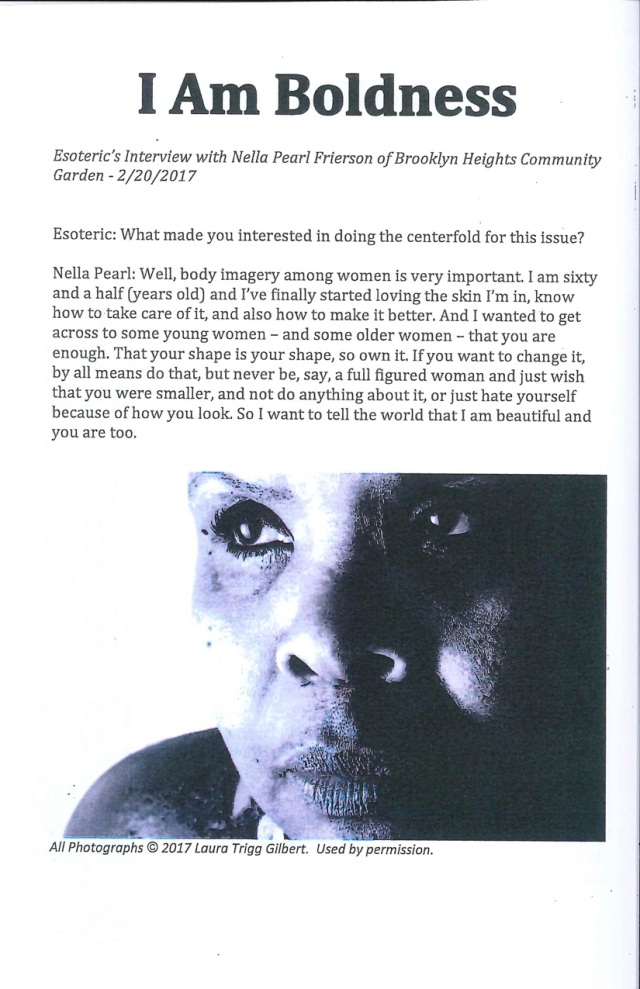
Page 7: I Am Boldness
Esoteric’s Interview with Nella Pearl Frierson of Brooklyn Heights Community Garden - 2/20/2017
Esoteric: What made you interested in doing the centerfold for this issue?
Nella Pearl: Well, body imagery among women is very important. I am sixty and a half (years old) and I’ve finally started loving the skin I’m in, know how to take care of it, and also how to make it better. And I wanted to get across to some young women – and some older women – that you are enough. That your shape is your shape, so own it. If you want to change it, by all means do that, but never be, say, a full figured woman and just wish that you were smaller, and not do anything about it, or just hate yourself because of how you look. So I want to tell the world that I am beautiful and you are too.
[Image description: The portrait is a very close crop of Nella Pearl Frierson’s face. Her face is serious and she is looking to the left, so that the right side of her face is partially in shadow. She is wearing black eyeliner. Her lips are closed and she has small moles around her right eye.]
All Photographs © 2017 Laura Trigg Gilbert. Used by permission.
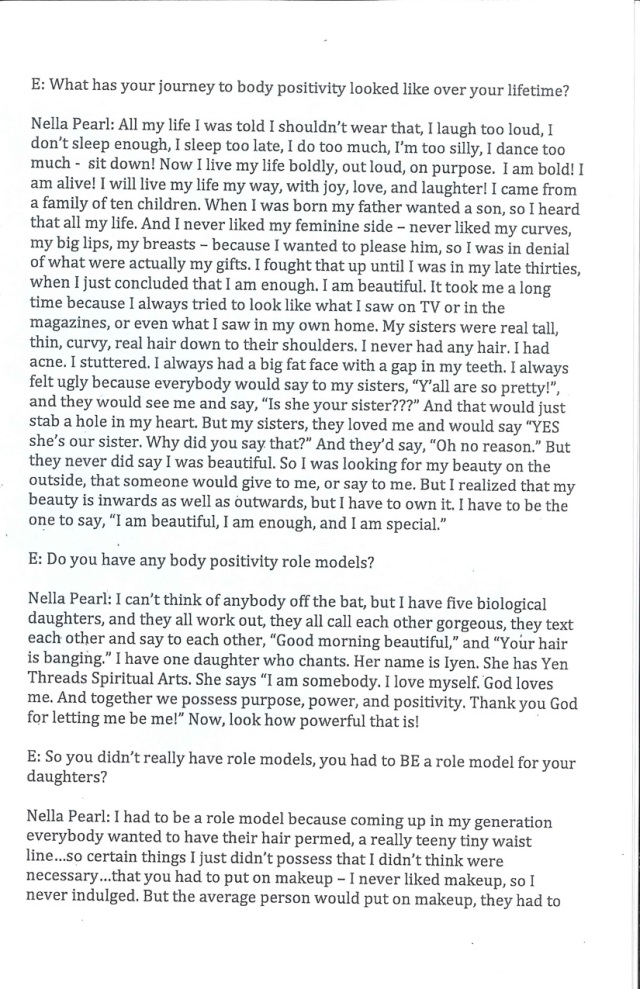
Page 8: I Am Boldness – no images
E: What has your journey to body positivity looked like over your lifetime?
Nella Pearl: All my life I was told I shouldn’t wear that, I laugh too loud, I don’t sleep enough, I sleep too late, I do too much, I’m too silly, I dance too much - sit down! Now I live my life boldly, out loud, on purpose. I am bold! I am alive! I will live my life my way, with joy, love, and laughter! I came from a family of ten children. When I was born my father wanted a son, so I heard that all my life. And I never liked my feminine side – never liked my curves, my big lips, my breasts – because I wanted to please him, so I was in denial of what were actually my gifts. I fought that up until I was in my late thirties, when I just concluded that I am enough. I am beautiful. It took me a long time because I always tried to look like what I saw on TV or in the magazines, or even what I saw in my own home. My sisters were real tall, thin, curvy, real hair down to their shoulders. I never had any hair. I had acne. I stuttered. I always had a big fat face with a gap in my teeth. I always felt ugly because everybody would say to my sisters, “Y’all are so pretty!”, and they would see me and say, “Is she your sister???” And that would just stab a hole in my heart. But my sisters, they loved me and would say “YES she’s our sister. Why did you say that?” And they’d say, “Oh no reason.” But they never did say I was beautiful. So I was looking for my beauty on the outside, that someone would give to me, or say to me. But I realized that my beauty is inwards as well as outwards, but I have to own it. I have to be the one to say, “I am beautiful, I am enough, and I am special.”
E: Do you have any body positivity role models?
Nella Pearl: I can’t think of anybody off the bat, but I have five biological daughters, and they all work out, they all call each other gorgeous, they text each other and say to each other, “Good morning beautiful,” and “Your hair is banging.” I have one daughter who chants. Her name is Iyen. She has Yen Threads Spiritual Arts. She says “I am somebody. I love myself. God loves me. And together we possess purpose, power, and positivity. Thank you God for letting me be me!” Now, look how powerful that is!
E: So you didn’t really have role models, you had to BE a role model for your daughters?
Nella Pearl: I had to be a role model because coming up in my generation everybody wanted to have their hair permed, a really teeny tiny waist line…so certain things I just didn’t possess that I didn’t think were
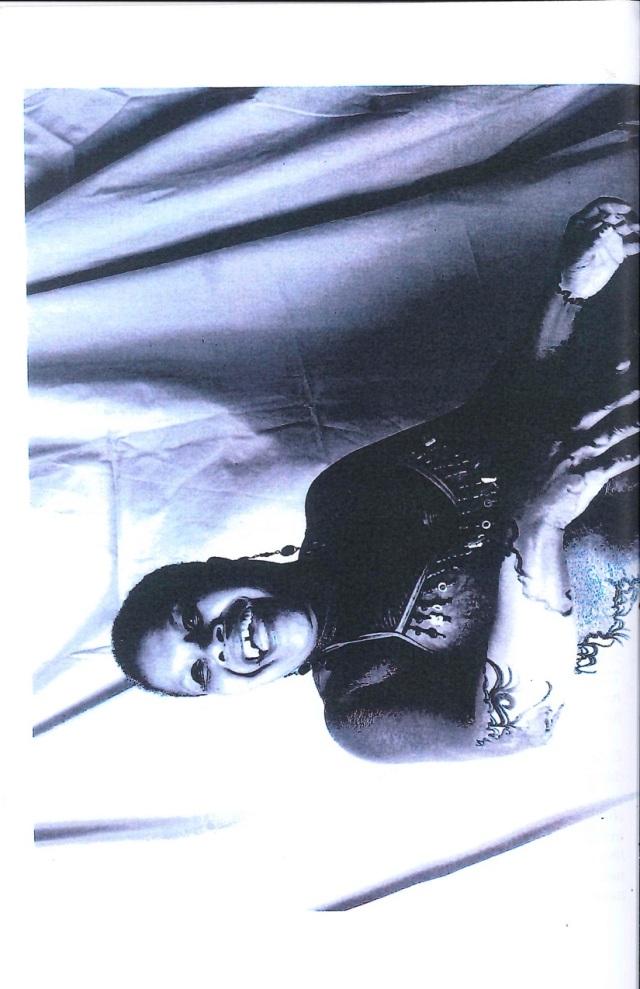
Pages 9-10: Centerfold: [Ms. Pearl is standing in front of draped white material. She is wearing a bikini that has bells and little gems hanging along its hemline, and body paint in an abstract pattern curls up from her feet to her legs, belly, and shoulders. Her hair is cropped very short, almost shaved, and she is wearing dangly earrings. She is looking to the left of the camera and her entire face smiles. She is lit up with joy.]
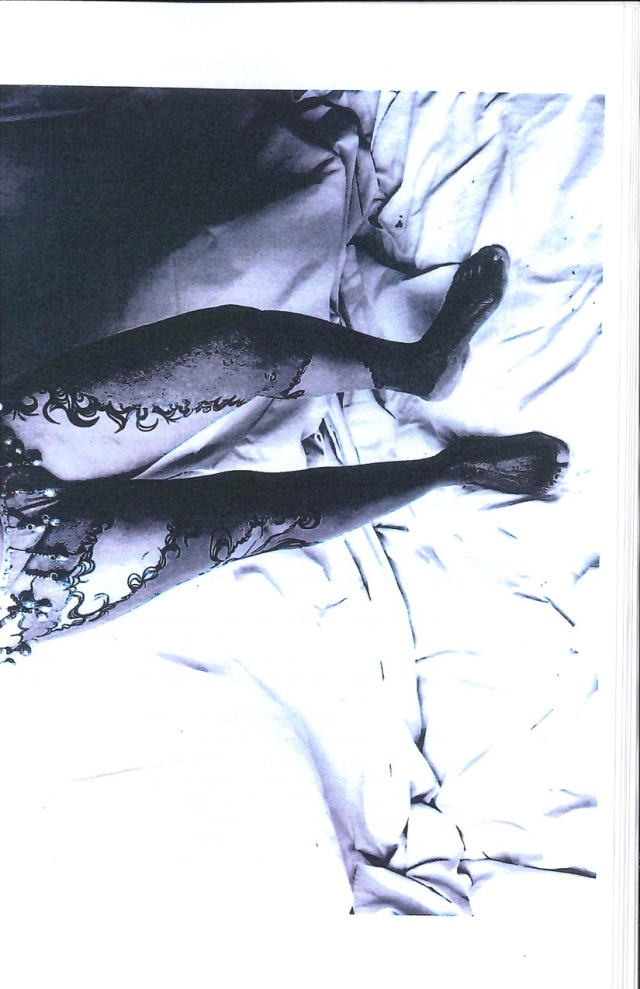
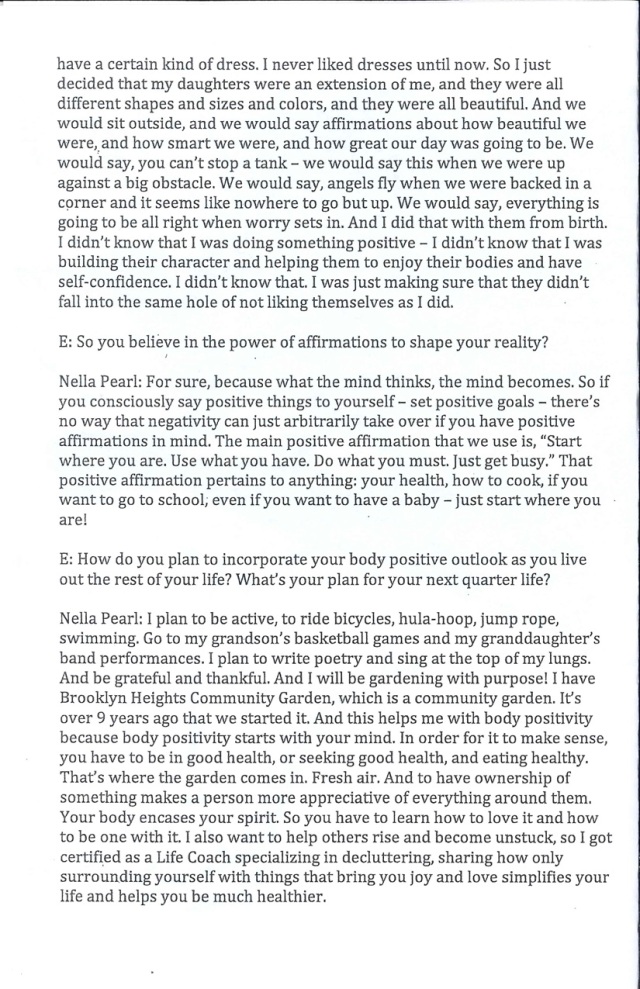
Page 11: I Am Boldness – no images
necessary…that you had to put on makeup – I never liked makeup, so I never indulged. But the average person would put on makeup, they had to
have a certain kind of dress. I never liked dresses until now. So I just decided that my daughters were an extension of me, and they were all different shapes and sizes and colors, and they were all beautiful. And we would sit outside, and we would say affirmations about how beautiful we were, and how smart we were, and how great our day was going to be. We would say, you can’t stop a tank – we would say this when we were up against a big obstacle. We would say, angels fly when we were backed in a corner and it seems like nowhere to go but up. We would say, everything is going to be all right when worry sets in. And I did that with them from birth. I didn’t know that I was doing something positive – I didn’t know that I was building their character and helping them to enjoy their bodies and have self-confidence. I didn’t know that. I was just making sure that they didn’t fall into the same hole of not liking themselves as I did.
E: So you believe in the power of affirmations to shape your reality?
Nella Pearl: For sure, because what the mind thinks, the mind becomes. So if you consciously say positive things to yourself – set positive goals – there’s no way that negativity can just arbitrarily take over if you have positive affirmations in mind. The main positive affirmation that we use is, “Start where you are. Use what you have. Do what you must. Just get busy.” That positive affirmation pertains to anything: your health, how to cook, if you want to go to school, even if you want to have a baby – just start where you are!
E: How do you plan to incorporate your body positive outlook as you live out the rest of your life? What’s your plan for your next quarter life?
Nella Pearl: I plan to be active, to ride bicycles, hula-hoop, jump rope, swimming. Go to my grandson’s basketball games and my granddaughter’s band performances. I plan to write poetry and sing at the top of my lungs. And be grateful and thankful. And I will be gardening with purpose! I have Brooklyn Heights Community Garden, which is a community garden. It’s over 9 years ago that we started it. And this helps me with body positivity because body positivity starts with your mind. In order for it to make sense, you have to be in good health, or seeking good health, and eating healthy. That’s where the garden comes in. Fresh air. And to have ownership of something makes a person more appreciative of everything around them. Your body encases your spirit. So you have to learn how to love it and how to be one with it. I also want to help others rise and become unstuck, so I got life and helps you be much healthier.
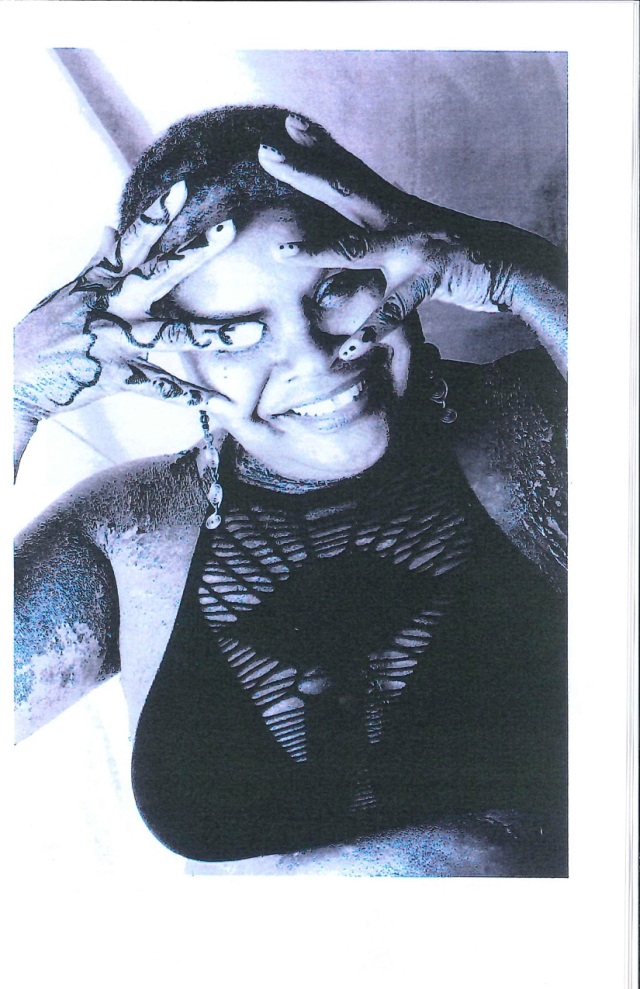
Page 12: I Am Boldness: [The image is of Ms. Pearl’s torso, arms and head. She is wearing a black mesh halter top with a web-like pattern across her breasts. Her fingers, which have black body paint spiraling and dotting them, are splayed across her face. She peeks through her fingers playfully, smiling with one eye covered by a finger. Her hair is closely cropped and she is wearing dangly earrings.]
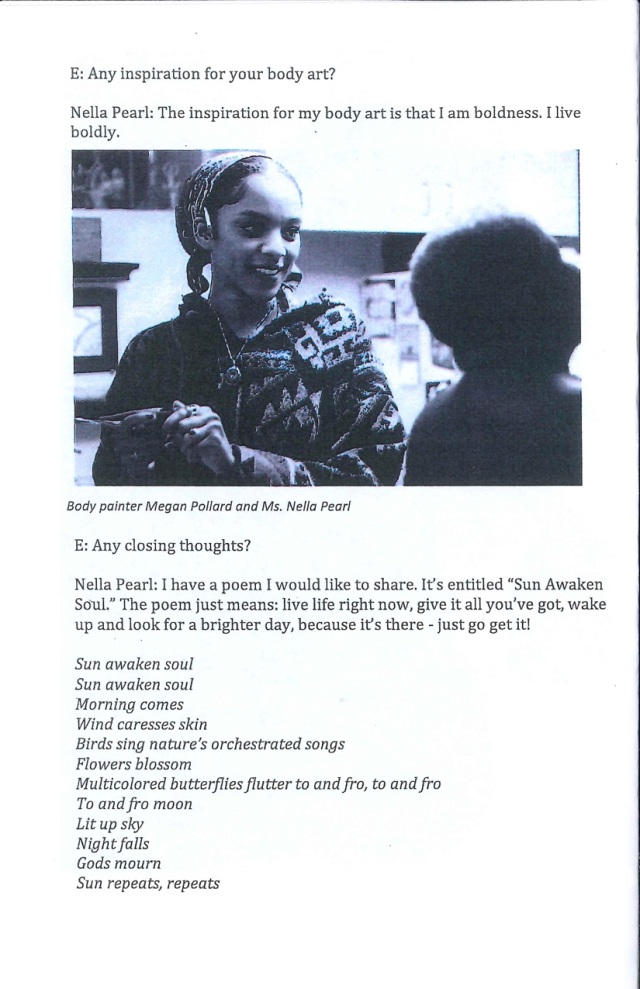
Page 13: I Am Boldness: [Image description: A young woman has a scarf wrapped around her hair and a pen or brush has been pushed under the scarf to free her hands. She is looking at Ms. Pearl, whose back is to the camera. The look on her face is a half-smile, a look of happiness and engagement with her subject. She is wearing a pull-over with a graphic pattern and a medallion around her neck. On her fingers she wears several rings and is opening a bottle of paint.]
E: Any inspiration for your body art?
Nella Pearl: The inspiration for my body art is that I am boldness. I live boldly.
E: Any closing thoughts?
Nella Pearl: I have a poem I would like to share. It’s entitled “Sun Awaken Soul.” The poem just means: live life right now, give it all you’ve got, wake up and look for a brighter day, because it’s there - just go get it!
Sun awaken soul
Sun awaken soul
Morning comes
Wind caresses skin
Birds sing nature’s orchestrated songs
Flowers blossom
Multicolored butterflies flutter to and fro, to and fro
To and fro moon
Lit up sky
Night falls
Gods mourn
Sun repeats, repeats
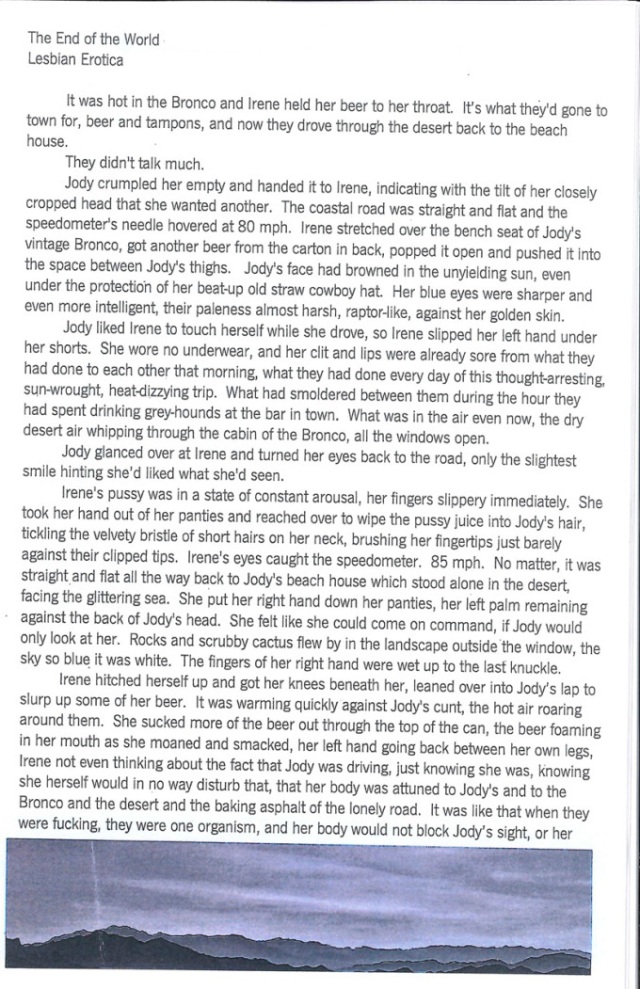
Pages 14-16: The End of the World:
It was hot in the Bronco and Irene held her beer to her throat. It’s what they’d gone to town for, beer and tampons, and now they drove through the desert back to the beach house.
They didn’t talk much.
Jody crumpled her empty and handed it to Irene, indicating with the tilt of her closely cropped head that she wanted another. The coastal road was straight and flat and the speedometer’s needle hovered at 80 mph. Irene stretched over the bench seat of Jody’s vintage Bronco, got another beer from the carton in back, popped it open and pushed it into the space between Jody’s thighs. Jody’s face had browned in the Baja sun, even under the protection of her beat-up old straw cowboy hat. Her blue eyes were sharper and even more intelligent, their paleness almost harsh, raptor-like, against her golden skin.
Jody liked Irene to touch herself while she drove, so she slipped her left hand under her shorts. She wore no underwear, and her clit and lips were already sore from what they had done to each other that morning, what they had done every day of this thought-arresting, sun-wrought, heat-dizzying trip. What had smoldered between them during the hour they had spent drinking greyhounds at the bar in town. What was in the air even now, the dry desert air whipping through the cabin of the Bronco, all the windows open.
Jody glanced over at Irene and turned her eyes back to the road, only the slightest smile hinting she’d liked what she’d seen.
Irene’s pussy was in a state of constant arousal, her fingers slippery immediately. She took her hand out of her panties and reached over to wipe the pussy juice into Jody’s hair, tickling the velvety bristle of short hairs on her neck, brushing her fingertips just barely against their clipped tips. Irene’s eyes caught the speedometer. 85 mph. No matter, it was straight and flat all the way back to Jody’s beach house which stood alone in the desert, facing the glittering sea. She put her right hand down her panties, her left palm remaining against the back of Jody’s head. She felt like she could come on command, if Jody would only look at her. Rocks and scrubby cactus flew by in the landscape outside the window, the sky so blue it was white. The fingers of her right hand were wet up to the last knuckle.
Irene hitched herself up and got her knees beneath her, leaned over into Jody’s lap to slurp up some of her beer. It was warming quickly against Jody’s cunt, the hot air roaring around them. She sucked more of the beer out through the top of the can, the beer foaming in her mouth as she moaned and smacked, her left hand going back between her own legs, Irene not even thinking about the fact that Jody was driving, just knowing she was, knowing she herself would in no way disturb that, that her body was attuned to Jody’s – and to the Bronco and the desert and the baking asphalt of the lonely road. It was like that when they were fucking, they were one organism, and her body would not block Jody’s sight, or her
[Image description:Low desert landscape with lonely far-off hills and scrub in the foreground. The top three-quarters of the picture is sky. The same image at the bottom of each of these three pages]
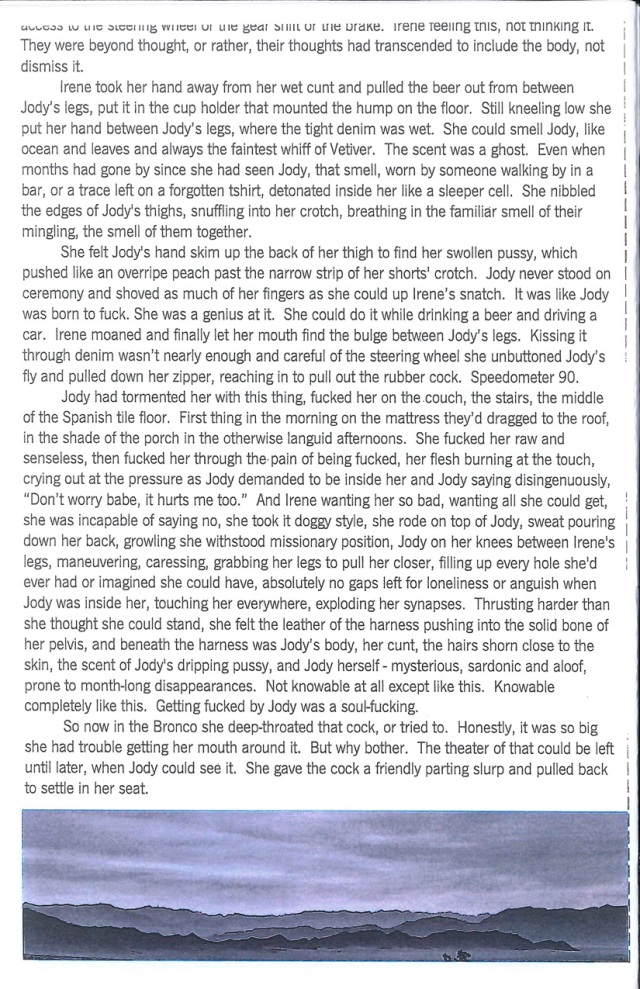
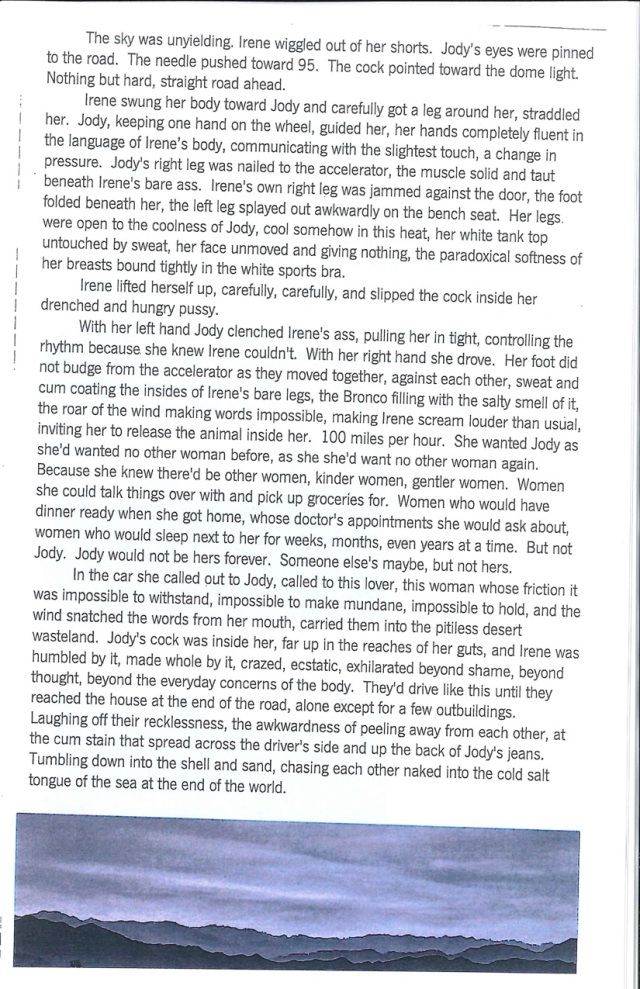
access to the steering wheel or the gear shift or the brake. Irene feeling this, not thinking it – they were beyond thought, or rather, their thoughts had transcended to include the body, not dismiss it.
Irene took her hand away from her wet cunt and pulled the beer out from between Jody’s legs, put it in the cup holder that mounted the hump on the floor. Still kneeling low she put her hand between Jody’s legs, where the tight denim was wet. She could smell Jody, like ocean and leaves and always the faintest whiff of Vetiver. The scent was a ghost. Even when months had gone by since she had seen Jody, that smell, worn by someone walking by in a bar, or a trace left a forgotten tshirt, detonated her like a sleeper cell. She nibbled the edges of Jody’s thighs, snuffling into her crotch, breathing in the familiar smell of their mingling, the smell of them together.
She felt Jody’s hand skim up the back of her thigh to find her swollen pussy, which pushed like an overripe peach past the narrow strip of her shorts’ crotch.
Jody never stood on ceremony and she shoved as much of her fingers as she could up Irene’s snatch. It was like she was born to fuck. She was a genius at it. She could do it while drinking a beer and driving a car. Irene moaned and finally let her mouth find the bulge between Jody’s legs. Kissing it through denim wasn’t nearly enough and careful of the steering wheel she unbuttoned Jody’s fly and pulled down her zipper, reaching in to pull out the rubber cock. Speedometer 90.
Jody had tormented her with this thing, fucked her on the couch, the stairs, the middle of the Spanish tile floor. First thing in the morning on the mattress they’d dragged to the roof, in the shade of the porch in the otherwise languid afternoons. She fucked her raw and senseless, then fucked her through the pain of being fucked, her flesh burning at the touch, crying out at the pressure as Jody demanded to be inside her and Jody saying disingenuously, “Don’t worry baby, it hurts me too.” And Irene wanting her so bad, wanting all she could get, she was incapable of saying no, she took it doggy style, she rode on top of Jody, sweat pouring down her back, growling she withstood missionary position, Jody on her knees between Irene’s legs, maneuvering, caressing, grabbing her legs to pull her closer, filling up every hole she’d ever had or imagined she could have, absolutely no gaps left for loneliness or anguish when Jody was inside her, touching her everywhere, exploding her synapses. Thrusting harder than she though she could stand, she felt the leather of the harness pushing into the solid bone of her pelvis, and beneath the harness was Jody’s body, her cunt, the hairs shorn close to the skin, the scent of Jody’s dripping pussy, and Jody herself – mysterious, sardonic and aloof, prone to month-long disappearances. Not knowable at all except like this. Knowable completely like this. Getting fucked by Jody was a soul-fucking.
So now in the Bronco she deep-throated that cock, or tried to. Honestly, it was so big she had trouble getting her mouth around it. But why bother. The theater of that could be left until later, when Jody could see it. She gave the cock a friendly parting slurp and pulled back to settle in her seat.
The sky was unyielding. Irene wiggled out of her shorts. Jody’s eyes were pinned to the road. The needle pushed toward 95. The cock pointed toward the dome light. Nothing but hard, straight road ahead.
Irene swung her body toward Jody and carefully got a leg around her, straddled her. Jody, keeping one hand on the wheel, guided her, her hands completely fluent in the language of Irene’s body, communicating with the slightest touch, a change in pressure. Jody’s right leg was nailed to the accelerator, the muscle solid and taut beneath Irene’s bare ass. Irene’s own right leg was jammed against the door, the foot folded beneath her, the left leg splayed out awkwardly on the bench seat. Her legs were open to the coolness of Jody, cool somehow in this heat, her white tank top untouched by sweat, her face unmoved and giving nothing, the paradoxical softness of her breasts bound tightly in the white sports bra.
Irene lifted herself up, carefully, carefully, and slipped the cock inside her drenched and hungry pussy.
With her left hand Jody clenched Irene’s ass, pulling her in tight, controlling the rhythm because she knew Irene couldn’t. With her right hand she drove. Her foot did not budge from the accelerator as they moved together, against each other, sweat and cum coating the insides of Irene’s bare legs, the Bronco filling with the salty smell of it, the roar of the wind making words impossible, making Irene scream louder than usual, inviting her release the animal inside her. 100 miles per hour. She wanted Jody as she’d wanted no other woman before, as she she’d want no other woman again. Because she knew there’d be other women, kinder women, gentler women. Women she could talk things over with and pick up groceries for. Women who would have dinner ready when she got home, whose doctor’s appointments she would ask about, women who would sleep next to her for weeks, months, even years at a time. But not Jody. Jody would not be hers forever. Someone else’s maybe, but not hers.
In the car she called out to Jody, called to this lover, this woman whose friction it was impossible to withstand, impossible to make mundane, impossible to hold, and the wind snatched the words from her mouth, carried them into the pitiless desert wasteland. Jody’s cock was inside her, far up in the reaches of her guts, and Irene was humbled by it, made whole by it, crazed, ecstatic, exhilarated beyond shame, beyond thought, beyond the everyday concerns of the body. They’d drive like this until they reached the house at the end of the road, alone except for a few outbuildings. Laughing off their recklessness, the awkwardness of peeling away from each other, at the cum stain that spread across the driver’s side and up the back of Jody’s jeans. Tumbling down into the shell and sand, chasing each other naked into the cold salt tongue of the sea at the end of the world.

Pages 17-18: Cat-Cow
- Get on your hands and knees (Table-top pose).
- Knees are directly under your hips - about 2-fists worth (6-8 inches) of space between your knees. Thighs are perpendicular to floor. (Your hips are not as wide as you think.)
- Wrists are right underneath your shoulders (maybe 8-12 inches between hands). Arms are straight.
- Find a neutral spine: tail-bone gently reaching toward back of your mat – this is more of an energetic feeling than a movement. Heart and crown of head is reaching gently toward the front of mat. Lengthening out the spine and find neutral space: shoulders not hunched, back not bowed. Shoulders gently pulling away from ears to make sure neck is long and shoulders not hunched. Very lightly tuck/lift in the belly. Don’t suck in your belly and hold your breath, just gentle engagement of abdominal muscles. (This helps stabilize the low back.)
Cow Pose - Inbreath
- Let the back bend. Tailbone and crown of your head lift up to ceiling. Heart is lifting forward and up. Shoulders stay away from the ears. Shoulder blades stay down the back. Gaze up toward the ceiling. Front of throat and neck feels very long and spacious. You’re a calm and stable cow.
Cat Pose - Outbreath
- Tailbone and crown of head lower to floor. Back of the heart (space between shoulder blades) lifts towards ceiling. Chin falls toward the chest. Gaze toward the navel. You’re an angry Halloween cat.
Repeat Cow and Cat pose, back and forth, staying with your breath. Start with at least 5 rounds. (One round includes a cat and a cow.)
Thoughts:
Let the breath guide the movement. Inhale for the entire movement of the Cow pose. Exhale for the entire movement of the cat pose. Breathe through your nose. You want the breath to be smooth and even. Start with a 4-count on your breath (count to 4 for each inhale, and 4 for each exhale). No need to rush - let the body feel relaxed. Once you get the hang of it, you might like to close your eyes and really tune into the breath.
Finishing up
Sit back on your heels or in a cross-leg position and be inside your body.
Benefits of regular cat-cow pose include: gentle spinal loosening and warm-up; ently loosens shoulders and hips; tunes you into your breath.
FB: @yogibassistnashville
Insta: @yogibassist
Email: yogibassist@gmail.com. questions or interested in private lessons or where you can find Jo-Jo teaching classes in Nashville
3 images. 1 [A woman is on her hands and knees on a yoga mat. She is in front of a bright window and a guitar is propped to the right of the window. Her head is toward the guitar. Her back is horizontal, with no bowing, and her gaze is between her hands.] 2. [The same woman, still on her hands and knees, is now looking up toward the wall in front of her. Her butt sticks out and up and her back is now bowed into a U-shape.] 3. [Still on her hands and knees, the woman has now rounded her back up toward the ceiling like an angry cat. The crown of her head points toward the floor and her gaze is toward her legs.]
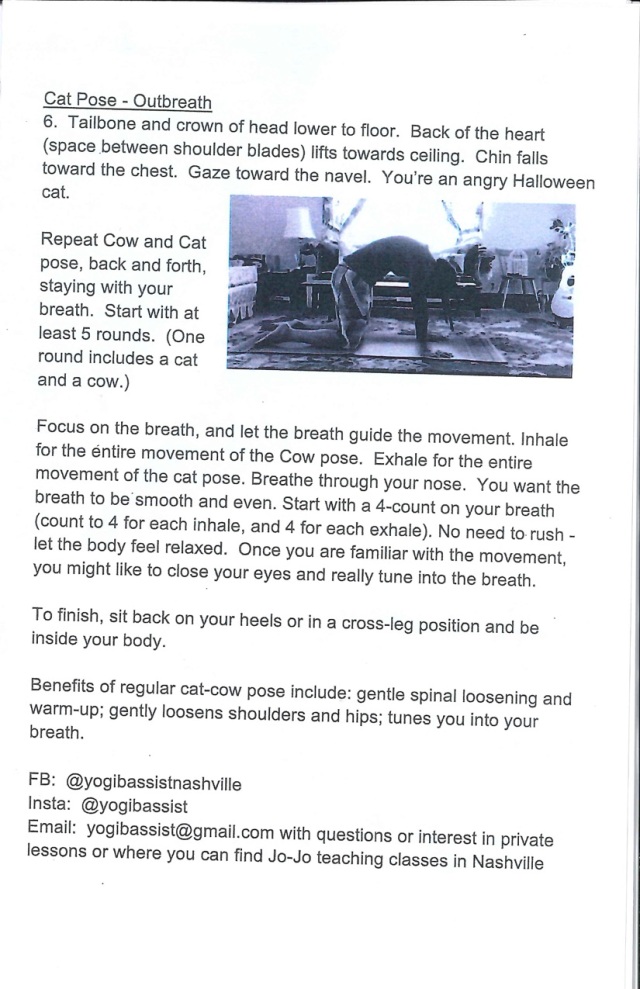
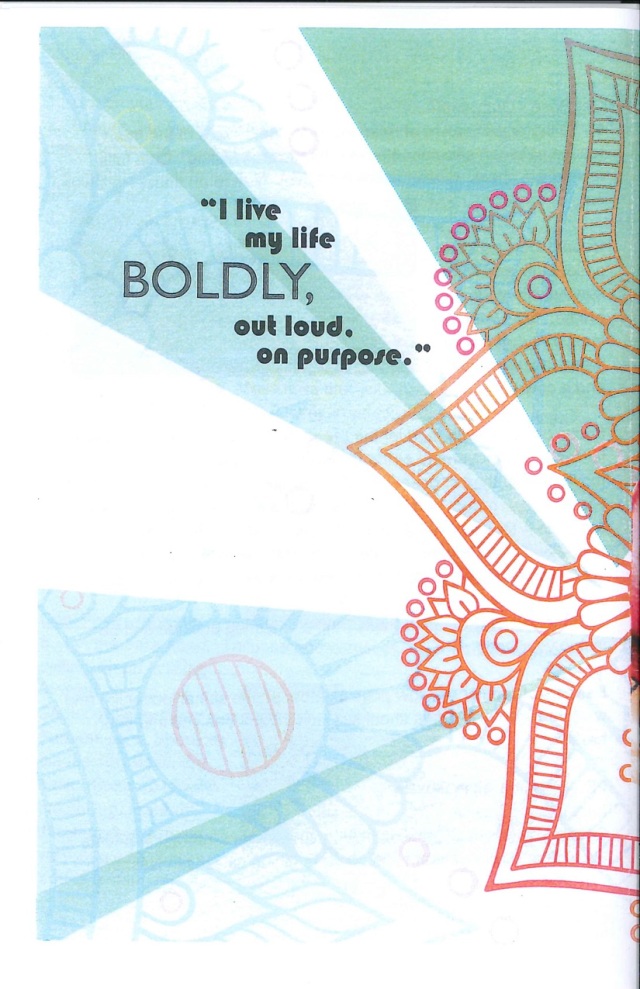
Back cover: [Blue and red floral patterns lightly cover a white and green background. A quote reads, “I live my live BOLDLY, out loud, on purpose.”]
For the full PDF version of Issue 2, click here.
Volume 2, Issue 1: The Risk Issue
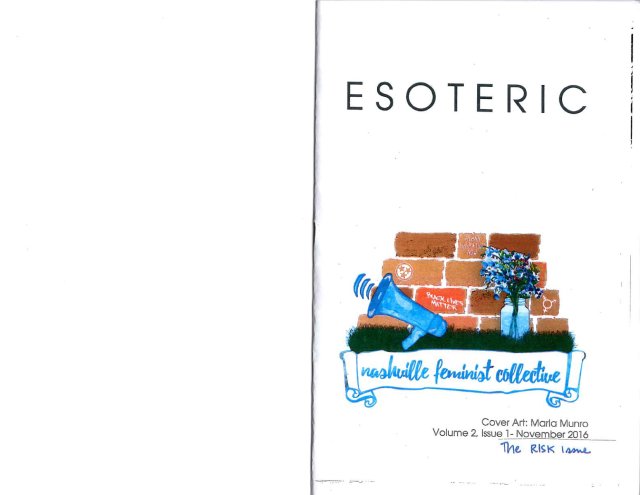
On the top of the front cover in all caps is the title “ESOTERIC” in the center.
Lower on the page is the image of the bottom of a red brick wall. Drawn on individual bricks in white are: “Trans Liberation Now,” the three stars of the Tennessee state flag, “Black Lives Matter,” and the Trans gender symbol. The brick wall sits on a patch of green grass. On the grass is a megaphone and a large mason jar with flowers and water. Below the wall is a blue scroll that says “Nashville Feminist Collective” in blue ink.
In the bottom right corner, in black ink, reads: “Cover art: Marla Munro,” below that: “Volume 2, Issue 1 - November 2016,” and then in a person’s print: “The Risk Issue.”
Across the first two pages are the six values of the Nashville Feminist Collective. They are in black text in white text boxes. On the bottom right corner of page 2 is a link to the Nashville Feminist Collective website. The box says: “find us on FB or at nashvillefeministcollective.com and become a member.” On the background of the two pages is a textured black and print.
Across pages 3 and 4 is a review of Beyonce’s Formation tour performance in Nashville. The background of page three is an image of pop superstar Beyonce. She is a black woman with elaborate makeup and long blonde hair; she is wearing some sort of fur coat. There are five text boxes of pulled quotes on that picture, as well as longer text box at the bottom of the page.
The background of page 4 is another image of Beyonce: her hair is in a ponytail and her hand is on her face. There are three large text boxes on top of this picture. At the bottom of the page are five text boxes of pulled quotes.
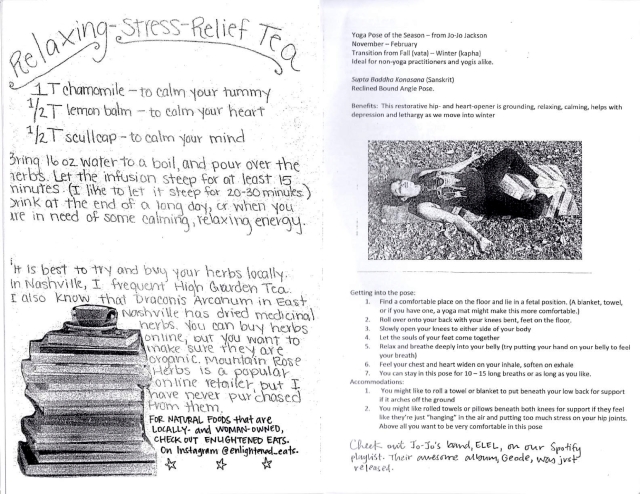
All the text on page 5 is handwritten. The title of the page reads “Relaxing-Stress-Relief-Tea.” The ingredients with properties are listed first:
1T Chamomile - to calm your tummy
1/2T Lemon Balm - to calm your heart
1/2T Skullcap - to calm your mind
Under the ingredients are instructions:
Bring 16oz. Water to a boil, and pour over the herbs. Let the infusion steep for at least 15 minutes. (I like to let it steep for 20-30 minutes.) Drink at the end of a long day, or when you are in need of some calming, relaxing energy.
Below the instructions are some recommendations for where to locally buy herbs:
It is best to try and buy your herbs locally. In Nashville, I frequent High Garden Tea. I also know that Draconis Arcanum in East Nashville has dried medicinal herbs. You can buy herbs online, but you want to make sure they are organic. Mountain Rose Herbs is a popular online retailer, but I have never purchased from them. For natural woods that are locally and woman-owned check out Enlightened Eats on Instagram @enlightened_eats.
On page 6, there is a section of text explaining the seasonal yoga pose that reads:
Yoga Pose of the Season - from Jo-Jo Jackson
November - February
Transition from Fall (vata) - Winter (kapha)
Ideal for non-yoga practioners and yogis alike
Supta Baddhua Konasana (Sanskrit)
Reclined Bound Angle Pose.
Benefits: This restorative hip- and heart-opener is grounding, relaxing, calming, helps with depression and lethargy as we move into winter.
There is an image of Jo-Jo Jackson, a black woman with a short afro doing the yoga pose. She is laying on her back on a yoga mat. Under the picture are the instructions for the pose:
Getting into the pose:
- Find a comfortable place on the floor and lie in a fetal position. (A blanket, towel, or if you have one, a yoga mat might make this more comfortable.)
- Roll over onto your back with your knees bent, feet on the floor.
- Slowly open your knees to either side of your body.
- Let the souls of your feet come together.
- Relax and breathe deeply into your belly (try putting your hand on your belly to feel your breath).
- Feel your chest and heart widen on your inhale, soften on exhale.
- You can stay in this pose for 10-15 long breaths or as long as you like.
Accommodations:
- You might like to roll a towel or blanket to put beneath your low back for support if it arches off the ground.
- You might like rolled towels or pillow beneath both knees for support if they feel like they’re just “hanging” in the air and putting too much stress on your hip joints. Above all you want to be very comfortable in this pose.
Handwritten at the bottom of the page is information about Jo-Jo: Check out Jo-Jo’s band, El El, on our Spotify playlist. Their awesome album, Geode, was just released.
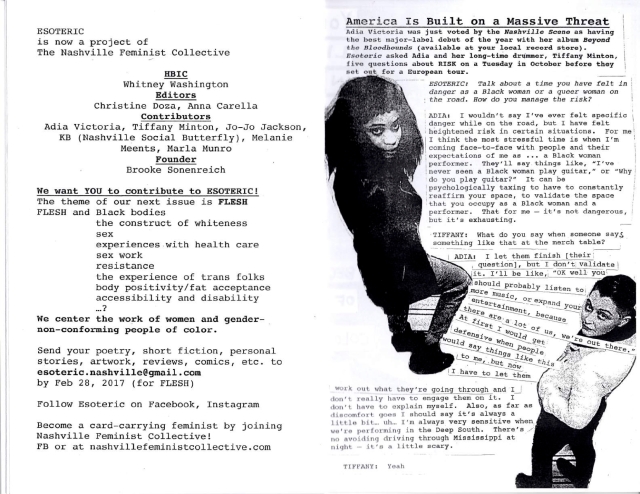
The centerpiece of this issue of Esoteric features an interview with musician Adia Victoria and her drummer Tiffany Minton, answering questions by Esoteric. The interview is in 12 white text boxes with in black text. On the background of the pages is a duplicated low resolution black and white image of Adia Victoria, a black woman with long braids, playing guitar. In the middle fold is a pull quote in black text on white text boxes that says “Your life can be taken from you because of the color of your skin.”
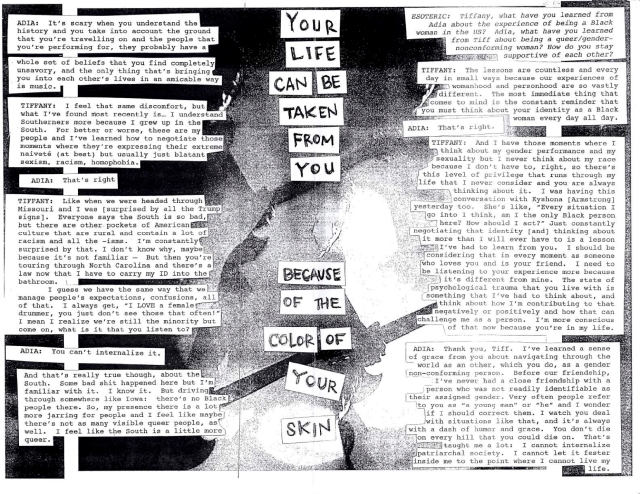
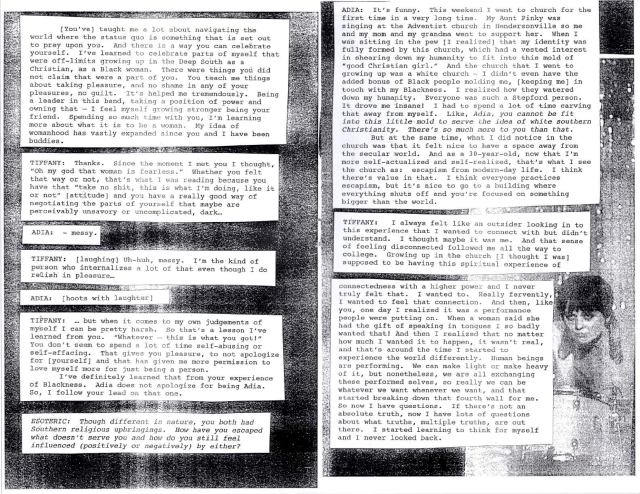
Image on bottom right is in black and white of a black woman with long hair gazing left into the fold of the zine. Hair is covering the left side of her face. She is holding a microphone and appears to be singing. The image appears to be cut out along the left side of the image and pasted onto the zine page (with the text described above pasted over the picture).
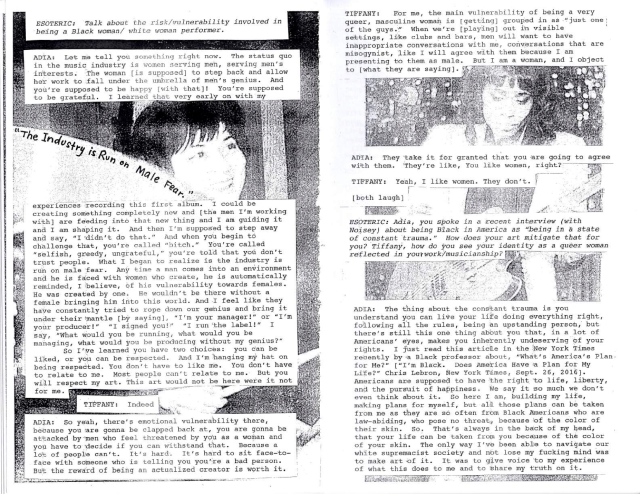
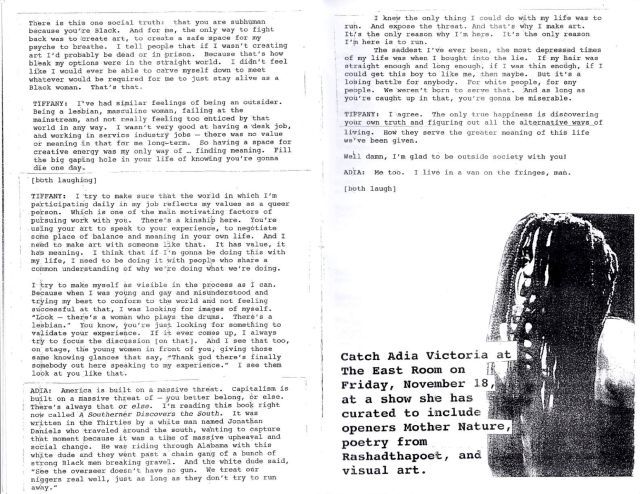 Full page in black and white. Top half of page consists of text of Adia Victoria and Tiffany Minton Interview. Bottom half has text in larger font in bold on left hand side of page. Bottom right shows black and white image of Adia Victoria singing.
Full page in black and white. Top half of page consists of text of Adia Victoria and Tiffany Minton Interview. Bottom half has text in larger font in bold on left hand side of page. Bottom right shows black and white image of Adia Victoria singing.
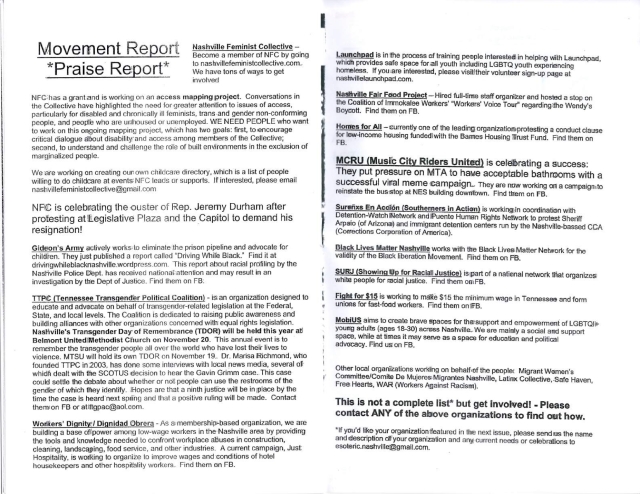
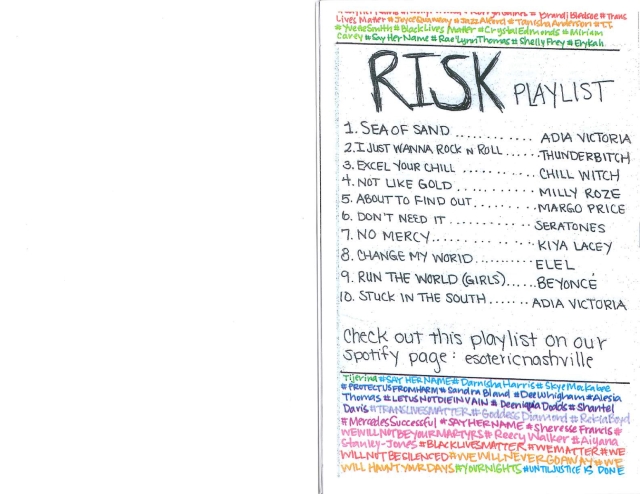
Back has multi-colored text on white paper. It is written by hand. The top text, in rainbow colors, are hashtagged names from the Black Lives Matter and Say Her Name movements. In large letters, it says “Risk Playlist” and lists songs and artists. There is a link to the spotify station for the zine. On the bottom of the page there are more names in rainbow text.

